
ISSUE 80 BUSINESS | LIFESTYLE | DESIGN THE DESIGN, ARCHITECTURE & URBAN PLANNING EDITION
CLEARING THE PATH: AI'S ROLE IN RESHAPING URBAN MOBILITY
Alexiei Dingli / 24
PRESERVING THE PAST, CONSTRUCTING THE FUTURE
Patrick Calleja / 28
BRIDGING FUTURES COVER STORY
Martin Spiteri and Simon Abela / 20
FOUNDATIONS OF TOMORROW Engineering the future of recruitment
Jacques Borg Barthet / 14

Liquidity Management Accounts - giving you the power to manage your liquidity.
Overnight deposits for professional customers - our goal is to support you in optimising your returns.
Our suite of services are geared to support our customers with their banking requirements allowing access to world markets, interest rates and foreign exchange services - a personalised service through one relationship. T: E: PrivateBanking@sparkasse-bank-malta.com
Speak to an advisor today. Sparkasse Bank Malta plc, 101 Townsquare, Ix-Xatt ta’ Qui-si-Sana, Sliema SLM3112, Malta.
Sparkasse Bank Malta plc is a public limited liability company registered in Malta with registration number C27152 and registered office at 101 Townsquare, Ix-Xatt ta’ Qui-si-Sana, Sliema SLM3112, Malta. Sparkasse Bank Malta plc is licensed by the Malta Financial Services Authority to carry out the business of banking in terms of the Banking Act (Cap. 371 of the Laws of Malta), and to provide investment services and custody and depositary services in terms of the Investment Services Act (Cap. 370 of the Laws of Malta).

Banking Investments - a personalised service through one relationship.
Banking | Custody | Investments


Editor’s note — In a world grappling with unprecedented challenges and opportunities, in this month's edition of MONEY, we delve into the transformative realms of design, architecture, and urban planning, casting a spotlight on the Maltese Islands at the crossroads of change. Our cover story, featuring Martin Spiteri of M Recruitment, sets the stage for a broader discussion on how strategic foresight in recruitment is essential to building the future of engineering and, by extension, shaping our urban landscapes. Spiteri and engineering consultant, Simon Abela's goal, is to close the talent and opportunity gap at a time when the engineering sector is experiencing severe talent shortages and high attrition rates. By doing this, they will ensure the ongoing evolution of our built environment. Their innovative strategies and dedication to excellence transform recruitment and lay the foundation for the following architectural and urban development eras.
This edition extends beyond our cover story to explore various facets of design, architecture, and urban planning in Malta. Giselle Borg Olivier's insightful conversation with Perit Jacques Borg Barthet reveals the current state and future aspirations of architectural education, offering a glimpse into the minds of those who will shape Malta's urban future.
Professor Alexiei Dingli introduces us to an AI-driven traffic management system that promises to revolutionise urban mobility in Malta, tackling the perennial congestion challenge with cutting-edge technology. This initiative addresses a critical local issue and positions Malta as a potential model for cities worldwide grappling with similar challenges.
Vanessa Macdonald's interview with Patrick Calleja, president of Din l-Art Ħelwa, and Konrad Buhagiar's reflections on the 'Connecting with
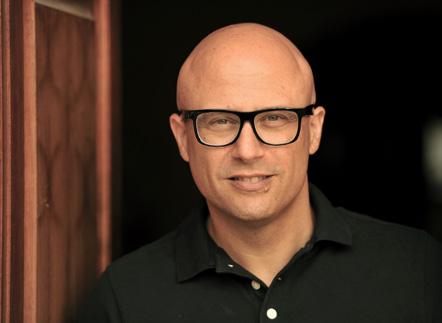
Nature' conference further enrich our theme. Together, they emphasise the importance of integrating sustainable architecture with heritage preservation and the imperative of reconnecting with the natural world in our urban environments.
From the visionary projects awarded the Pritzker Architecture Prize to the critical discussions on sustainable urban design and economic evolution, this edition of Money traverses the spectrum of design, architecture, and urban planning. It celebrates the innovative solutions and visionary leadership driving Malta towards a sustainable and aesthetically enriching future.
As you explore these pages, we invite you to reflect on the profound impact of design, architecture, and urban planning
on societal well-being, economic vitality, and environmental sustainability. Join us in envisioning a future where thoughtful design and strategic planning create spaces that are lived in and cherished.

[bemags.com/money-pitch] · [hello@bemags.com]

ISSUE 80 MONEY 06 WELCOME All rights reserved. Reproduction in whole or in part is strictly prohibited without written permission. Opinions expressed in Money are not necessarily those of the editor or publisher. All reasonable care is taken to ensure truth and accuracy, but the editor and publishers cannot be held responsible for errors or omissions in articles, advertising, photographs or illustrations. Unsolicited manuscripts are welcome but cannot be returned without a stamped, self-addressed envelope. The editor is not responsible for material submitted for consideration. Money is published by Be Communications Ltd, No. 36/1, Amery Street, Sliema SLM 1702 FACEBOOK-SQUARE LINKEDIN · [becommunications.com] MONEY is hand-delivered to Malta’s businesses, including managers and directors of the country’s top bluechip companies, iGaming companies, all 5-star hotels, including their business centres, executive lounges and rooms (where allowed), all foreign embassies and Maltese embassies abroad
Belgium, France, Germany, Italy, Spain,
All government ministries and entities. For information regarding promotion and advertising:
EDITOR Anthony P. Bernard PRINTING Print It DISTRIBUTION MaltaPost DESIGN Be.Communications
(Austria,
UK).


For more info: T: 21 383 383 E: sales.malta@hilton.com SCAN FOR MORE
EVENTS by HILTON MALTA

ALL-ELECTRIC MAZDA MX- ḃḀ
YOURS FOR €23,000
INCL. GOVERNMENT GRANTS
TERMS AND CONDITIONS APPLY

ENERGY: WHAT MOVES YOU. ELECTRIFIED.
Is development a dirty word?
At a time when everyone and their dog has an opinion about the built environment across the Maltese Islands, Giselle Borg Olivier sat down with Perit Jacques Borg Barthet, visiting senior lecturer in the Faculty for the Built Environment at the University of Malta and director of practice at AP Valletta, to discover what graduating architects are being taught about the situation and what they think about the sector that they've decided to join.
On the brink of a breakthrough?
In the face of rising urban congestion, traditional traffic management solutions have often fallen short. In an exclusive interview with MONEY, Professor Alexiei Dingli unveils the journey behind developing an AI-driven traffic management system in Malta that challenges and redefines the status quo. The stakes couldn't be higher, with congestion costing Malta approximately €400 million annually in lost productivity and environmental damage. Dingli's approach promises an improvement and a revolution in navigating urban environments. This daring initiative addresses Malta's unique traffic dilemmas and might offer a blueprint for global cities struggling with congestion crises.
Engineering the future of recruitment

Talent shortages and high attrition rates have put the engineering recruitment landscape at a crossroads in 2024. M Recruitment, a Malta-based agency led by chief operations officer Martin Spiteri and supported by engineering consultant Simon Abela, is determined to revolutionise the sector. In an exclusive interview with Dayna Camilleri Clarke, we uncover their innovative strategies and unwavering commitment to bridging the gap between talent and opportunity, propelling the industry into a new era of success.
Working now to protect tomorrow
Vanessa Macdonald speaks to Patrick Calleja, the new president of Din l-Art Ħelwa, about his vision for Malta's urban future, the imperative of safeguarding cultural heritage, and the transformative power of sustainable architecture in the face of ongoing developmental challenges.
Smart Malta: The road to transformative localities
JP Fabri discusses Malta's journey towards becoming a smart locality, which showcases how integrating innovative technologies can transform local communities. Focusing on economic growth, improved public services, and enhanced quality of life, this visionary approach highlights the universal benefits of smart cities, even in smaller communities like Malta.
Riken Yamamoto: Sharing spaces, connecting communities
In an era where architecture shapes societies as much as it does skylines, Riken Yamamoto's contributions are a testament to the transformative power of thoughtful design. Awarded the 2024 Pritzker Architecture Prize, Yamamoto's work transcends traditional boundaries, fostering communal interactions and integrating nature with urban life. MONEY delves into the visionary projects that underscore his commitment to creating spaces that are lived in and experienced.
Bridging nature and urbanism
In the glorious setting of the Auberge de Provence, adorned with neo-Pompeian murals and a profusion of floral decorations, the Malta International Contemporary Arts Space (MICAS) hosted the 'Connecting with Nature' conference last autumn. Konrad Buhagiar delves into the discussions held against a backdrop symbolising a deep-seated reverence for nature, convening experts and enthusiasts to explore the human imperative to reconnect with the natural world amidst the challenges of burgeoning urban populations and escalating urbanisation.
The 'S' Factor
In the shifting real estate industry, sustainability goes beyond the environment to embrace social values, the 'S' in ESG. Nicole Grima explores this vital yet underappreciated aspect, showing how diversity, equity, and inclusion (DEI) in projects enhance community well-being and advance the sector's goals for net zero and sustainability.
ISSUE 80 MONEY 10 CONTENTS
36 38
24
COVER STORY
14 28 32
44
20
48
54
Malta’s crossroads: The urgent need for sustainable urban planning Strategise to capitalise
David Grima highlights the critical role of urban design in enhancing well-being and economic prosperity. As he reflects on his observations from Western countries and contrasts them with Malta's oversight in urban planning, he argues for the transformative power of green spaces, quality infrastructure, and thoughtful urban layouts to improve life quality and support tourism, urging Malta to prioritise its natural and urban landscapes.
50
Before the next economic model
Manuel Delia delves into Malta's economic evolution in his thought-provoking piece, questioning the entrenched belief that politics is negligible in shaping economies. Tracing Malta's journey from a strategic colonial outpost to a modern economic player, he explores the island's adaptive strategies amidst global shifts, underscoring the critical need for visionary leadership in forging a sustainable and inclusive economic future.
52
Revolutionising machinery safety
Ing. Stephen Mallia explores the transformative impact of the EU's new machinery regulation. Set for enforcement in January 2027, this regulation promises to elevate safety standards, embrace technological adaptability, and harmonise regulations across the European Economic Area, including Malta, revolutionising the machinery sector.
Thomas Cremona offers business owners a masterclass in preparing for a lucrative sale. Uncover strategic planning insights for seamless management buyouts, optimal shareholder divestments, and structuring your business to attract the right buyers.
56
Love and money
Luca Caruana delves into the heart of financial discord in relationships, unravelling the complexities that money matters weave into the fabric of partnerships. He explores the indispensable role of compromise, the nuanced dance of managing debt and investments, and the power of proactive financial planning.
58
Planning the urban spaces we deserve
Ed Muscat Azzopardi discusses the evolution of city planning with Catherine Barratt, the managing director of Furnitubes. Ed examines the shift from efficiency-driven urban design to human-centric design and how past oversights in planning have necessitated a reevaluation of public spaces.
60
Forms of beauty
MONEY's pick from the world's best designers.







Dayna, a former newspaper editor and journalist, is a wordsmith extraordinaire. With a knack for crafting impeccable marketing text and brand manifestos, she effortlessly balances grammar and brand voice. Throughout her varied career, Dayna has shaped narratives and inspired both colleagues and clients alike to lead global brands.
Ed was born in 1977 and is, to the disappointment of many, still not dead. He tells stories for a living, engages in a host of activities that don’t involve actual physical activity, and likes food, film, travel, and cameras.
Giselle is a marketing professional, and independent writer and proofreader. She runs Content for Success.
JP is a founding partner at Seed, a multi-disciplinary advisory practice.
Manuel is a civil society activist and writer.
Stephen is a freelance product regulatory compliance expert and mechanical engineer with over 13 years of experience in the field, providing practical client-focused advice.
Vanessa had every intention of retiring but so far has been caught up by exciting freelance projects and voluntary work.
MONEY THE DESIGN, ARCHITECTURE & URBAN PLANNING EDITION 11 CONTENTS MONEY's columnists —




ISSUE 80 MONEY 14 ARCHITECTURE
Is development
At a time when everyone and their dog has an opinion about the built environment across the Maltese Islands, Giselle Borg Olivier sat down with Perit Jacques Borg Barthet, visiting senior lecturer in the Faculty for the Built Environment at the University of Malta and director of practice at AP Valletta, to discover what graduating architects are being taught about the situation and what they think about the sector that they've decided to join.
a dirty word?
MONEY THE DESIGN, ARCHITECTURE & URBAN PLANNING EDITION 15 ARCHITECTURE
As we settle down for the interview in a beautifully restored Valletta building, I explain to Jacques that I want to start with definitions of commonplace terms because the development topic is on everyone's lips. Not everyone is aware of the different responsibilities and parameters for each role.
In a typical development, the developer takes the most significant risk from a financial position and is, therefore, the person whose interest is to limit such risk. They're not looking for projects that are unlikely to get a permit or involve complications at an added cost. And that is symptomatic of local development because developers are only interested in design if they think it will give them a competitive advantage. Nowadays, there are rumblings about more quality development providing a competitive edge in the market. Still, traditionally, it is 'you build it as fast as you can, you sell it as fast as you can'. Of course,
respond more sensibly. This may be due to the maturity of our economy and, therefore, our exposure to the impacts of either economic decisions or cultural and economic issues. The time gap with other jurisdictions is shrinking, making our governance issues more acute.
For a long time, the local debate was about the environment versus development—a false dichotomy. We must ask ourselves, 'What kind of environment do we want, for the quality of life that we want, for the well-being that we want, and what economic model can deliver that?'
Given the scale of land ownership in Malta, we're all affected by development, and understanding building rights and land value is a powerful part of our psyche. There are two false mantras – development equals progress, and development is a dirty word. We know we are not happy with the environment taking shape, but we need
Developers are only interested in design if they think it will give them a competitive advantage.
Traditionally, it is ‘you build it as fast as you can, you sell it as fast as you can’.
there are those developers who deal in the high-end sector of the market who would have a slightly different vision, but fundamentally, the motives are the same.
When one looks around, it's hard not to notice that Malta is increasingly becoming grey due to the use of concrete for buildings. Yet, we pride ourselves on mastering limestone and the yellow rock typically associated with Maltese houses. Is limestone still important, and are we at risk of running out of this stone?
A recent post on social media highlighted the obvious fact that the issue of good design in Urban Conservation Areas (UCAs) is not about the use of limestone but about context and proportion. The use of the material doesn't guarantee anything; a good design in limestone remains a good design. We should certainly be thinking nationally about our limestone reserves and what these should be primarily retained for, e.g., restoration and repairs – in the decades to come.
When you study topics like planning, you realise that the challenges the country is experiencing are not unique to us, though, in some ways, we tend to experience a delay factor. We experience problems that will have been encountered elsewhere 20 years earlier, giving us some time, in truth, to
to think about understanding, conceiving, and creating the environment we want. That will require a suitable governance framework because the built environment is affected by decisions in various policy sectors and because improvement will not come from policy safeguards alone but from creating public or private agencies to design and deliver improvement.
What's the stand on the preservation of old houses in this regard?
Anything already built has an embodied energy value, so if it exists, it's already taken an environmental cost to build it. So, presumably, the last thing we should do is demolish it and add to the waste stockpile to invest energy to build something new – unless it's so unfit for purpose that it cannot be renovated. You will find that students primarily identify with that mindset, and therefore, buildings must last. We should be designing buildings that are so beautiful, up to standard, and adaptable that we would never want to tear them down.
Of course, this doesn't mean that building interventions shouldn't be made. The best buildings survive because they are adaptable to changes in lifestyle, technology, and community needs. They then rely on skilled professionals
ISSUE 80 MONEY 16
ARCHITECTURE
to intervene in the most delicate way possible, respecting the building's qualities.
If we don't think we can design beautiful buildings today, then we have a severe problem.
Exactly! So why are most apartment blocks so bland and uninspired? Are we reverting to the developer mentality of 'give me the best you can for the cheapest you can'?
It's certainly part of it. Another aspect is that most of these developments are allowed to take place on individual traditional plots that are long and relatively narrow, lending themselves to a particular configuration. However, the issue is that not all buildings are the same. If one takes Valletta as an example, there's a lot of uniformity in material and proportion; there is a balance of variety and order. The buildings are not low, and the streets are similar to any other part of Malta, so why is it that Valletta works while the roads of flats in the suburbs of most towns and villages don't?
Firstly, the blocks in Valletta were designed more holistically and were built to be adaptable to accommodate the changing use requirements. In contrast, much of the current development is single-plot without integral planning or design. There is often outcry about significant developments; I think we miss the wood for the trees in not realising that the incremental impact of many small interventions, where many integral issues that needed to be considered weren't, has been much more significant than the impact of large developments.
If someone were to develop a whole street holistically, they would address issues like parking, the layout of the units on the plot, etc. But because everybody is only concerned with developing their plot according to what the policy permits, no attention is paid to these other more significant issues.
And remember that nobody designs the street. If you ask most Maltese people to think of a street, the image immediately comes to mind is something about 10 ½ meters wide with a 1.2-metre pavement on each side, and the rest is tarmac for cars. But when we travel, the streets don't necessarily look like that. When I speak to students at university, one of the first discussions we always have is, 'We're going to have to deal with our mental database', because if I say 'street', they're all going to bring up the same image, and we need to challenge that.
The street is where we live, where we should interact, and where we should meet other people. It's the supporting infrastructure that provides access to our residential property or place of work; however, it's also what we look at and where we breathe when we're walking—if we dare to walk.
A few years ago, for her dissertation, one of my students interviewed elderly people in Birkirkara; she was told: 'I'm perfectly able-bodied, but I don't walk out of my house because the pavement is so bad that I'm so afraid that I will fall and injure myself and end up bedridden, that I prefer to stay at home!'
Similarly, some parents no longer trust their children to walk two blocks
to the grocer on their own. If you consider the social and mental health cost to both the elderly and the children (because it's always the most vulnerable who are the least protected), it's enormous.
Many studies have shown how the inability to move outside within degrees of freedom impacts children's emotional and independent development. Moreover, there is also a broader societal cost to older people who won't leave their houses because they need to rely on someone to provide for them since they cannot lead independent lives.
We tackle all these issues throughout the course; however, we must recognise that specific issues are also cultural challenges – in much the same way that we think public transport should improve so that somebody else will take the bus. Until the roads are choked full of cars, nothing will be done.
We need to raise awareness about the status quo's shortcomings and create enough demand for improvement—meaning we need to understand what that improvement might be—to hopefully pressure people to realise that we can't continue encouraging the current situation. Somebody, at some point, will have to make hard decisions. Culture changes slowly, but we are not doing enough.
The National Statistics Office (NSO) reported that 1,292 new dwellings were approved during the last quarter of 2023; 1,075 comprise apartments and penthouses. Why are apartment blocks being built in such numbers?
There are a couple of things: there is an issue of policy design and the affordability factor. If a plot owner can now build four floors in an area previously designated for two floors, they're unlikely to build a fourstorey house. Hence, the policy has encouraged redeveloping twostorey terraced housing into apartments over several floors.
Affordability is also a huge issue because there is demand on the market due to an increasing population. Statistics presented in studies done by some of the large auditing firms have noted that a large proportion of people are looking for property in the €300,000 range, which is the pricing entry-level today, and simply put, houses are not sold at that price. There is a general policy approach to keep the construction industry as buoyant as possible because it's considered to somehow be good for the economy – but this has an impact.
This is where the governance dynamic comes into play. Somebody decided that a person owning a two-storey house could develop a four-storey property, but no holistic considerations were made about the street. Had developers been told that they would be permitted to develop but would have to say, set back their building two metres from the road, and those two metres must become part of the public realm, eventually, the street would be four metres wider; that would allow for organising a decent pavement with space for street trees, and the opportunity to balance the space for the car and other street users.
What we have now is the result of this equation: intensified development on the plot with the street infrastructure remaining as it is.
And it's doubtful that it will change… →
MONEY THE DESIGN, ARCHITECTURE & URBAN PLANNING EDITION 17
ARCHITECTURE
We say that, but at the same time, we are, by design, changing Malta right now. If I look out on the horizon, I see cranes everywhere. Property is being demolished or redeveloped across Malta. We are actively changing parts of the island; we must ask, 'Why have we chosen to do it this way?'
If it is necessary to increase densities, there are other ways of doing it, but this requires research and investigation into legislative matters. Simply put, it doesn't fit the model of keeping things as simple as possible for the developer – in much the same way that converting houses in UCA is more problematic as an investment model than building something from scratch. Ultimately, we must live with the results of our choices.
As citizens, we have a voice to use. To some extent, we are responsible for being as informed as possible to make our voices heard rationally. Still, we also need to be able to demand better from those responsible for providing us with planning and urban design infrastructure.
On February 16th, the media reported that developers (MDA) and architects (KTP) had joined forces by signing the National Building Council to lobby the government jointly to increase standards within the construction industry. What is the importance of merging/ aligning forces?
This is mainly about managing construction and site regulations rather than planning and urban design considerations. It looks like a situation where two important stakeholders sit down and say, ' Together, hopefully, we have a stronger voice to draw attention to the fact that certain things need to be done better.'
When entities collaborate, it's typically for the greater good rather than everyone working in silo.
In principle, the more entities collaborate, discuss, and raise common concerns, the better. However, once we get sufficient synergy between stakeholders to agree that they want a better environment and better management, it's going to happen. Ultimately, both the MDA and the KTP are system clients.
Nobody is responsible for designing the public realm; to an extent, it is within the remit of local councils, but their capacity is limited, and the impact on the public realm due to what is happening on plots is severe.
One needs to study the situation, understand the problem, and then address the issue to reach an objective. Suppose I aim to have a better environment that reflects people's needs for a better quality of life. In that case, we need to understand what a better-built environment is, what it should do and for whom, and ultimately, who will be responsible for it.
Where do you think an entity like Project Green comes into this picture?
Project Green might be the first agency tasked with improving the public realm or creating spaces targeted to better well-being. Whether that will happen through individual sites or contribute to building a network
integrated with the country's other needs is an important consideration.
To me, creating green infrastructure is a significant element of what we should seek to achieve. How do we develop streets that people want to walk in? How do we create commuter routes that people feel safe to cycle in? How does this infrastructure also help to deal with issues like flooding?
Green infrastructure will also contribute to lowering urban temperatures and carbon capture. We have to face those challenges, but we've decided not to.
Have we reached the point of no return in terms of land space?
Since the war, the land area we built has grown roughly six or seven times while our population has doubled. Therefore, land per person has grown three times. We have developable land areas that are wellestablished and safeguarded. I say reasonably because developments still occur in Outside Development Zones (ODZ); however, ODZ is not a black-and-white issue. Of course, we should not be encouraging developments in ODZ, but there are developments that one wouldn't want in a residential area.
How do you define the space between Swatar and Msida? Technically, it's ODZ; it's not built. There are fields, but they're not used as agricultural land, so what purpose are they serving and for whom? How do we view those spaces as part of the city, and therefore, how do they contribute to the city's overall well-being as parks or accessible nature areas, for example? The biggest issue is the quality of the environment in which we live.
What is it like when people step across their front door into the street and look out of their window or balcony? What does it look like, but what is it like acoustically? What is the air quality like? Is it safe and comfortable to walk? What is the temperature of it? Those are crucial questions that we need to explore and answer.
Having discussed many of the development issues we're experiencing, I delve into the academic side of the industry (since that is where our architects are emerging from, albeit not necessarily the contractors and developers). What is the structure of the degree obtained from the Faculty for Built Environment?
The three-year Bachelor of Science (B.Sc.) degree comprises a Bachelor's in Built Environment Studies, which is a prerequisite to read for the master's degree in the final two years of the course, where students choose either the architecture or civil engineering routes (with options) to then get their warrant according to their chosen discipline
– Perit Arkitett or Perit Enġinier. The degree is preceded by a Design Foundation diploma wherein students are equipped with tools, such as drawing and modelling, to communicate their ideas.
What's being taught about safeguarding land?
That's something other than what you teach per se; you teach an understanding of the outlook required to achieve more sustainable development.
ISSUE 80 MONEY 18
ARCHITECTURE
What you'll find with today's graduates is that they're very concerned about the state of the environment. By the third year of their course, many are thinking, 'I came into this because I believe in beauty and the relationship with landscape... Is this the environment that I'm going to be working in?' I think that, for the most part, people who enter this field do so because they have an interest in designing beautiful things, despite knowing that they're entering a market where their opportunity to do so will be constrained to a large degree by the circumstances they end up working in and that there are limits to what their influence will be when they are working.
The word' limits' piques my interest. Who is the ultimate decision maker in the building industry – the architect who designs, the contractor who builds, or the developer who pays?
If it's your money and your investment, you have the final say within the regulatory framework that you operate; it is the architect's job to advise clients to act in a way that reflects their interests but also to consider the broader impacts of development on society and the environment at large. There should be an element of concern about the greater well-being and the impact of a development on the environment, from energy performance to streetscape. Of course, the aspect of concern varies from one architect to another. Nevertheless, this is an area that is instilled in the teaching practices at the university, especially in the project tutoring modules, where students apply the theory taught to the design of a project.
Is climate change a cause for consideration and discussion during lectures and tutorials?
Yes, students are undoubtedly aware of and concerned
about these issues. For the past few years, we've run the first part of the final master's project as a group project, where all the students research a theme and then compile a report and strategy. We deal with topical considerations like green infrastructure, mobility, and rising sea levels… therefore, climate change is a regular concern.
Architecture is a very particular profession because it's not like a mathematical equation that is either right or wrong. Most of the challenges in the early years of the course are about students understanding the nature of that iteration. There's a 1970s text by Zeisel that says that design is a spiral process – you're moving along in a general direction but in a spiral because every piece of new information updates the information you had previously and changes the overall shape of things. You present and receive feedback, which also alters the definition of the problem. This is the same at the university level and in the working world, where a client or other stakeholders (consultants, contractors, regulatory authorities) will present different considerations or requests. It's not a linear process; in the first few years, students adapt to understand that.
Given these issues, do young people still seek architecture as a career path?
Yes, I think so. Our final year cohort is around 40 people this year, which reflects the average. It's a five-year degree, so 40 architects or engineers enter the system annually.
Is that enough?
The issue is how many of those will find meaningful work. And how do we create situations where we develop the agencies that should be commissioning a better environment?
It's the architect's job to advise clients to act in a way that reflects their interests but also to consider the broader impacts of development on society and the environment at large.
Architect: A third party engages an architect to design a project. This would usually involve the design of layout and structure, including external finishes, sometimes internal design and finishes, and will proceed from concept through to the submission of planning applications, preparation of documents for the procurement of works, and inspection of the works on site. Contractor: The person employed to build or execute the work on site. Developer: Typically, the investor buys a piece of land or developable property as an investment, usually to resell. They're the people who engage the services of an architect and a contractor.
Contractors and developers are often interchangeable because some started as contractors before becoming developers, and others handle both roles.
MONEY THE DESIGN, ARCHITECTURE & URBAN PLANNING EDITION 19
ARCHITECTURE
Engineering the future of recruitment
Talent shortages and high attrition rates have put the engineering recruitment landscape at a crossroads in 2024. 73% of technical and STEM businesses worldwide report significant workforce gaps, with a staggering 40% attrition rate among young engineering professionals.
M Recruitment, a Malta-based agency led by chief operations officer Martin Spiteri and supported by engineering consultant Simon Abela, is determined to revolutionise the sector. In an exclusive interview with Dayna Camilleri Clarke, we uncover their innovative strategies and unwavering commitment to bridging the gap between talent and opportunity, propelling the industry into a new era of success.
ISSUE 80 MONEY 20 COVER STORY
Established ten years ago, the small team at M Recruitment initially focused on recruitment for the hospitality sector; since then, the company has grown exponentially, with six full-time recruitment specialists handling varying sectors, from retail to finding the best talent matches for C-level positions. Spiteri joined the firm three and a half years ago and has proved instrumental in steering M Recruitment into new pastures.
How do you foster a culture of innovation within your team, and what leadership strategies have you found most effective in driving team performance and satisfaction?
MS I strongly advocate for channelling creativity, embracing risk-taking, and encouraging experimentation. I believe in empowering everyone at M Recruitment to take calculated risks and explore new ideas without fear of failure. Creating an atmosphere where sharing innovative concepts is encouraged is paramount; it's time to move away from the stagnant "do as I say" culture that plagues many workplaces. Instead,

Change is not to be feared but embraced as the catalyst for growth and innovation.
— Martin Spiteri
I champion a mindset that pushes the boundaries of creativity and welcomes a culture of collaboration and bold exploration.
In addition to promoting creativity and risk-taking, I firmly believe in the principles of servant leadership and laissez-faire leadership. Servant leadership emphasises serving others first, prioritising their needs, and encouraging a supportive environment where individuals can thrive. Similarly, laissez-faire leadership encourages autonomy and trust, allowing team members the freedom to innovate and excel in their roles.
Moreover, I recognise the critical importance of coaching and mentoring staff, providing them with the guidance and support they need to reach their full potential. By investing in the growth and development of our team members, we not only cultivate a more skilled workforce but also a culture of continuous improvement and success.
Can you share an instance where you had to pivot your strategy in response to market conditions, and what lessons did you learn from that experience?
MS A decade ago, the construction and hospitality sectors were our primary focus, constituting what I affectionately termed our "bread and butter" domains. However, our evolution has been transformative, branching out into diverse sectors and services, including outsourcing,
HR solutions, and executive recruitment.
With a dedicated team of six recruitment specialists, each honing their expertise in distinct areas, we've sharpened our ability to pinpoint the perfect talent for our clients. Yet, we've encountered hurdles in our journey, notably the saturation of the local market with Third-Country Nationals (TCNs). The administrative burdens accompanying such a workforce became a bottleneck, leading to delays in permits and navigating shifting legislative landscapes like the advent of skills cards in hospitality.
Recognising the need for agility, we pivoted our strategy towards a 60% focus on direct services and a 40% focus on outsourcing. This shift has empowered us to act as an integral extension of HR departments, facilitating seamless onboarding and offering tailored policies and procedures. Through this journey, we've gleaned a fundamental truth: change is not to be feared but embraced as the catalyst for growth and innovation.
How do you see the role of recruitment agencies evolving in the next few years? What steps is M Recruitment taking to stay ahead of these changes and remain competitive?
MS Traditional recruitment techniques are relics of the past in →
MONEY THE DESIGN, ARCHITECTURE & URBAN PLANNING EDITION 21 COVER STORY
today's fast-paced digital landscape; online platforms' dynamic avenues have long surpassed them. We can no longer rely on newspaper advertisements to attract top-tier talent; instead, we must navigate many global recruitment databases, leveraging diverse licences to tap into a vast pool of candidates.
Adapting to this ever-evolving terrain isn't just a necessity—it's a mandate to stay ahead of the curve. Our younger team members, attuned to emerging trends and adept at exploring niche markets, play a pivotal role in our quest for excellence. Embracing an international workforce opens doors to a truly global talent pool, propelling us beyond geographical boundaries.
When a company entrusts us with their recruitment needs, it expects nothing short of exceptional talent that meets the technical requirements and seamlessly integrates with its organisational culture. We understand the stakes are high, and our commitment extends beyond mere box-ticking; we prioritise finding skilled candidates that align with our client's values and ethos. Our approach is holistic, drawing upon industry experts to ensure each candidate embodies the perfect fit. Through forging strong relationships with our clients, we've earned our reputation as a trusted partner, consistently delivering unparalleled service and exceeding expectations.
With Simon Abela joining M Recruitment to lead the new MEP and engineering recruitment segment, how do you envision his expertise complementing your current recruitment strategies? What immediate changes or initiatives are you planning to implement together?
MS Simon's arrival has been nothing short of transformative for our operations in this sector. With decades of invaluable experience in the MEP sector, he has become our guiding light in identifying the most exceptional candidates for these specialised roles. Collaborating closely, we've implemented innovative practices such as pre-interview case study assignments, enabling us to assess candidates' capabilities precisely and confidently, particularly in this niche sector.
This strategic shift in our approach has proven immensely influential, allowing us to discern technical prowess and crucial soft skills like communication. Simon's expertise extends beyond recruitment; he is pivotal in steering us towards the right segments and fine-tuning our strategies, ensuring we meet and exceed our targets. Our sights are set on a global expansion, aiming to attract larger international clients, and with Simon at our helm, we're poised to achieve unprecedented success worldwide.
Following Martin Spiteri's insightful responses, it's evident that M Recruitment is poised for remarkable growth under his leadership. Now, let's shift our focus to Simon Abela, whose strategic contributions are equally pivotal in shaping the agency's trajectory. Dayna Camilleri Clarke had the privilege of speaking with Simon to gain further insights into his role and the innovative approaches he brings.
With your rich background in smart building and Industry 4.0 technologies, how do you plan to leverage your industry insights to enhance M Recruitment's capabilities in headhunting for MEP and engineering positions? What makes your approach unique in
identifying and attracting top talent in these fields?
SA With over two decades as an electrical engineer and a deep-rooted understanding of the generic MEP industry as well as Extra Low voltage systems and smart buildings and Industry 4.0 technologies, my approach to enhancing M Recruitment's capabilities in recruiting for MEP and engineering positions is multifaceted. My industry insights afford me a nuanced comprehension of our client's needs, enabling us to tailor our recruitment efforts with unparalleled precision.
What sets our approach apart is our ability to identify top talent and understand the intricate technical requirements of each role. By leveraging my first-hand experience and industry knowledge, we ensure that candidates possess the requisite skills and align with our client's organisational goals and culture. This unique blend of expertise and insight allows us to attract and retain the best talent in these fields, positioning M Recruitment as an MEP and engineering recruitment leader.
In transitioning to a consultant role focusing on MEP and engineering positions, what added value do you believe your expertise brings to the recruitment process? How does your background enable M Recruitment to stand out in this new segment?
SA Transitioning to a consultant role focusing on MEP and engineering positions, my specific expertise brings an added layer of value to the unparalleled recruitment process. With a reputation firmly established within the industry, my endorsement carries significant weight, instilling confidence in clients and candidates. Having traversed the spectrum from engineer to client, I intimately understand the challenges and intricacies of filling niche roles within the MEP and engineering domains.
This first-hand experience equips me with a unique perspective, enabling me to ask the right questions and discern the perfect fit for each position. Moreover, my background underscores the importance of recognising the diverse standards and qualifications prevalent across different nationalities, ensuring a tailored approach that meets the specific needs of both clients and candidates. By leveraging this expertise, M Recruitment stands out in this new segment, offering insight and understanding that sets us apart from the competition and ensures unparalleled success in MEP and engineering recruitment.
Introducing technical case studies in the interview process is a novel approach. How do you envision these case studies improving the quality of candidates that M Recruitment can place? Can you share your methodology for creating case studies that reveal a candidate's potential and fit for a role?
SA Integrating technical case studies into the interview process significantly advances our recruitment methodology. By crafting tailored scenarios that mirror real-life challenges candidates may encounter in their roles, we gain invaluable insights into their problemsolving abilities, technical acumen, and overall fit for the position. These case studies serve as a potent screening tool, allowing us to assess candidates comprehensively before advancing to the interview stage. This approach ensures that candidates possess the requisite technical skills and provides a window into their reasoning process and soft
ISSUE 80 MONEY 22 COVER STORY
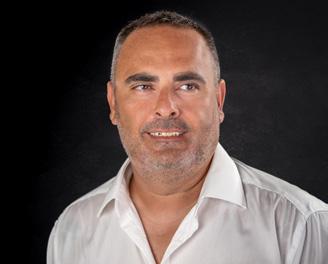
into their practical skills and capabilities. For instance, if a candidate claims proficiency as a fire alarm technician, we investigate whether they possess hands-on experience in system programming, installation, or theoretical knowledge. This meticulous approach allows us to identify candidates who meet and exceed our client's expectations, ensuring they are genuinely ahead of the curve in their knowledge and skills.
Your industry recognition and vast project experience are significant. How do you see these influencing your role in providing guidance and insights during recruitment, especially in preparing candidates for the evolving demands of the MEP and engineering sectors?
SA Using my extensive experience in the generic MEP as well as the smart building and automation projects as a guide, my advisory role at M Recruitment will take a futuristic approach that anticipates future skills and qualifications essential for success in the MEP and engineering job market. While emerging technologies like BIM Modelling present exciting opportunities, core skills remain fundamental across all trends.
By crafting tailored scenarios that mirror reallife challenges, we gain invaluable insights into candidates' problem-solving abilities, technical acumen, and overall fit for the position.
— Simon Abela
skills, such as communication and adaptability. By leveraging this methodology, we can offer our clients a holistic view of each candidate, facilitating more informed hiring decisions and ultimately elevating the quality of talent at M Recruitment.
Given the rapid advancements and specific demands in MEP engineering, how do you ensure that the candidates you shortlist for M Recruitment's clients are qualified and genuinely ahead of the curve in their knowledge and skills?
SA Staying abreast of rapid advancements and specific demands in MEP engineering is paramount to ensuring that the candidates we shortlist for M Recruitment's clients are qualified and at the forefront of their field. Our approach is multifaceted: we leverage our deep understanding of market trends to gauge candidates' level of engagement and passion for their craft.
Additionally, we employ a rigorous screening process that includes asking precise questions tailored to each candidate's expertise. By delving into their past projects and accomplishments, we gain insights
M Recruitment must stay attuned to these shifts while keeping a keen eye on sectors with promising potential, such as marine, offshore and oil and gas. Sustainability will continue to play a pivotal role, and candidates with expertise in this area will be highly sought after.
Moreover, as the engineering job market drives global economic productivity and national competitiveness, M Recruitment must adapt its strategies to meet these evolving needs. This includes leveraging the right platforms to identify and match top talent with the industry's demands, ensuring a seamless alignment between candidates and employers.
By embracing these trends and preparing accordingly, M Recruitment can remain at the forefront of the MEP and engineering job market, facilitating sustainable growth and prosperity for clients and candidates.
You can learn more about M Recruitment's services by visiting mrecruitment.eu.
MONEY THE DESIGN, ARCHITECTURE & URBAN PLANNING EDITION 23 COVER STORY
On the brink of a breakthrough?
Inside Alexiei Dingli's AI-driven traffic management system

In the face of rising urban congestion, traditional traffic management solutions have often fallen short, leaving cities worldwide searching for alternatives. In an exclusive interview with MONEY, Professor Alexiei Dingli unveils the journey behind developing an AI-driven traffic management system in Malta that challenges and redefines the status quo. The stakes couldn't be higher, with congestion costing Malta approximately €400 million annually in lost productivity and environmental damage. Dingli's approach, leveraging AI's untapped potential, promises an improvement and a revolution in navigating urban environments. This daring initiative addresses Malta's unique traffic dilemmas and might offer a blueprint for global cities struggling with congestion crises.
Professor Dingli, could you share with us the inspiration and journey that led to the development of the AI traffic management system? What specific challenges in Malta's traffic congestion did you aim to address with this technology?
The inspiration for the AI traffic management system stemmed from a blend of personal experience and a deep-rooted desire to contribute positively to my country. As a parent of three children, I'm acutely aware of the importance of road safety for our families. The challenges of traffic congestion in Malta are multifaceted, impacting our daily lives, health, and economy. Studies have shown that
traffic congestion and pollution in Malta cost around €400 million annually. This staggering figure encompasses the direct costs of traffic jams, the associated air pollution, and the negative impacts on public health and productivity. As the former mayor of Valletta, I have witnessed firsthand the stress and time lost in traffic, making us less productive as a society. My aim with this AI-driven solution was to address these critical issues. The technology focuses on optimising what we already have—our existing road network and infrastructure—using AI to alleviate congestion, reduce pollution, and, importantly, make our roads safer. By improving traffic flow and reducing the time spent in traffic, we
can enhance productivity and contribute to a healthier, more sustainable environment for all Maltese residents.
Your team has developed a sophisticated AI traffic load balancing algorithm that predicts and mitigates congestion. How does this algorithm work in real-time, and what makes it effective in ensuring an even distribution of traffic across Malta's road network?
Our AI traffic load balancing algorithm is a fusion of passive and active strategies, effectively orchestrating traffic flow across Malta's road network. Passively, the system works behind the scenes, subtly
ISSUE 80 MONEY 24 URBAN PLANNING

influencing traffic dynamics without direct driver awareness. This is achieved through interventions such as dynamic traffic light sequencing or adjustments to tidal lane configurations, to name a few. The AI system achieves this by analysing real-time data to optimise flow. For example, if one route is experiencing heavy traffic while others are clear, the system prioritises the congested route, reducing wait times and easing overall traffic congestion. This intelligent infrastructural adjustment ensures smoother traffic flow with minimal direct intervention in drivers' routines. On the active front, the system engages directly with road users, providing them with information and suggestions to make smart travel decisions.
This is done through mobile apps or electronic information boards in existence, which are already positioned strategically across the road network. The apps and boards relay real-time traffic updates, alert drivers to congestion ahead, and suggest alternative routes. This proactive information dissemination empowers drivers to make informed decisions, effectively distribute
Our initiative goes beyond mere traffic control; it's a bold statement against the inefficiency and pollution plaguing modern cities.
traffic, and mitigate congestion hotspots. By combining passive and active approaches, the AI algorithm provides an even distribution of traffic and a more efficient use of Malta's road infrastructure. This blend of subtle network modifications and direct user engagement enhances the system's overall effectiveness, making it an innovative solution to our unique traffic challenges.
Safety is a crucial aspect of road traffic management. Can you elaborate on how the AI-Enhanced Safety and Rule Enforcement feature works to identify traffic violations and improve road safety through real-time analytics?
The AI safety feature of our traffic management system is fundamentally engineered to prioritise road safety, focusing on detecting and preventing potential hazards. The emphasis is not just on identifying violations but, more crucially, on proactively responding to conditions that could lead to accidents, ensuring a safer driving environment for all. Central to this system is vehicle classification, which allows →
MONEY THE DESIGN, ARCHITECTURE & URBAN PLANNING EDITION 25 URBAN PLANNING
for the continuous monitoring and analysis of vehicular behaviour on the roads. This sophisticated AI functionality is adept at identifying patterns indicative of danger. For instance, if a vehicle is observed swerving erratically, this is flagged as a potential safety hazard, indicating a possible loss of control by the driver.
Similarly, the system recognises when drivers disregard critical traffic rules, such as running red lights. These are not mere traffic violations but potential precursors to more severe incidents and accidents. The system's response is calibrated for safety upon recognising such risky behaviours. Alerts are dispatched to the traffic enforcement authorities to facilitate timely interventions. This may involve deploying patrol units for onsite safety checks or issuing direct warnings to drivers. This strategy plays a vital role in diffusing potentially dangerous situations and preventing them from escalating into accidents.
Moreover, our AI system extends its capabilities to identify environmental and road conditions that could precipitate accidents, such as wet roads, poor visibility, or unexpected obstacles. By analysing data from traffic cameras in real time, the system can provide early warnings to drivers and traffic management authorities, enabling swift actions to avert potential accidents. It emerges as a comprehensive guardian of road safety, significantly reducing the likelihood of accidents and markedly improving the overall safety of our roads.
One of the standout features of your system is its ability to integrate with existing infrastructure. How does this integration work, and what challenges did you face in making the system adaptable and scalable for different urban environments?
Our model is centred around the principle of cost-effectiveness for localities adopting our AI traffic management system. I was the mayor of a capital city, so I perfectly understand the financial constraints that cities and communities face, especially when upgrading public infrastructure. Therefore, our approach is to utilise the existing local infrastructure more efficiently, aiming to bring cost savings that outweigh additional burdens.

Integrating our system with existing infrastructure involves a process that is both adaptable and resource-efficient. Essentially, we leverage the current network of traffic cameras, sensors, and control systems already in place in these localities. This means our system is designed to 'plug into' the existing setup, utilising the data and hardware that are already operational. One of the critical challenges in this integration process is ensuring compatibility with a wide range of existing technologies. Different cities may have varying types and ages of infrastructure, so our system is flexible enough to interface effectively with all of them. We've addressed this challenge by developing a modular software architecture. This means our system can be customised to fit the specific requirements of each urban environment, regardless of the diversity of their existing infrastructure. Another challenge is scalability. Urban environments vary significantly in size and complexity, so our system must be able to scale up or down according to the specific needs of each locality. We've tackled this by ensuring our software and algorithms are robust and versatile, capable of handling small-scale and large-scale urban traffic scenarios. Through this approach, we aim to make our AI traffic management system an accessible and practical solution for a wide range of urban environments, contributing to smarter, safer, and more sustainable cities.
Looking towards the future, how do you envision the global application of this
AI traffic management system? What potential impacts do you foresee on urban transportation, environmental sustainability, and the overall quality of life in cities adopting this technology?
Looking towards the future, I envision the global application of our AI traffic management system as a transformative force in urban transportation, environmental sustainability, and the overall quality of life in cities. This system's adaptability to different urban challenges makes it a viable solution for cities worldwide. Reducing traffic congestion can significantly lower carbon emissions, creating a cleaner and more sustainable environment. In terms of urban transportation, the system is designed to enhance efficiency, reduce travel times, and improve the quality of life for city dwellers. As seen in similar projects globally, such as Alibaba's City Brain, these technologies have the potential to decrease traffic by up to 20% and shorten the time for emergency vehicles, such as ambulances, to reach accident scenes by 50%. Such impactful results indicate the potential of AI traffic management systems to revolutionise city life. As we look ahead, I call upon cities and municipalities to embrace this technology as a step towards smarter, more livable urban environments. The potential to improve traffic flow, enhance public safety, and reduce environmental impact is immense. By adopting AI-driven traffic management, we can make significant strides in creating more efficient, safer, and sustainable cities for the future.
ISSUE 80 MONEY 26
URBAN PLANNING
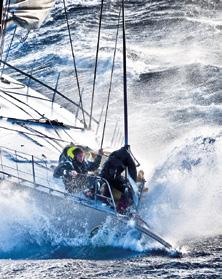


To advertise email hello@skippermag.com or visit bemags.com Follow us on SUMMER EDITION OUT JUNE! MALTA’S DEFINITIVE BOATS AND YACHTING MAGAZINE. P O WE R E D B Y Informative and exclusive content, high and lifestyle. Available at all marinas, boutique/hotels and sailing clubs. Now available at Porto Turistico Marina di Ragusa THE DEFINITIVE BOATS AND YACHTING MAGAZINE WINTER 23 ISSUE 32 COVER STORY NAVIGATING LIFE Chris Dougall: A sailor's journey from the early seas to the America's Cup 16 RMSR 2024 The 44th Rolex Middle Sea Race: Bullitt's victory and navigational feats 12 Peter Valentino on sailing's challenges and the call for renewed integrity 22 ERROR AFTER ERROR 24 WINTER PORTS OF CALL Enchanting winter ports: Europe's coastline transformed into snowy havens
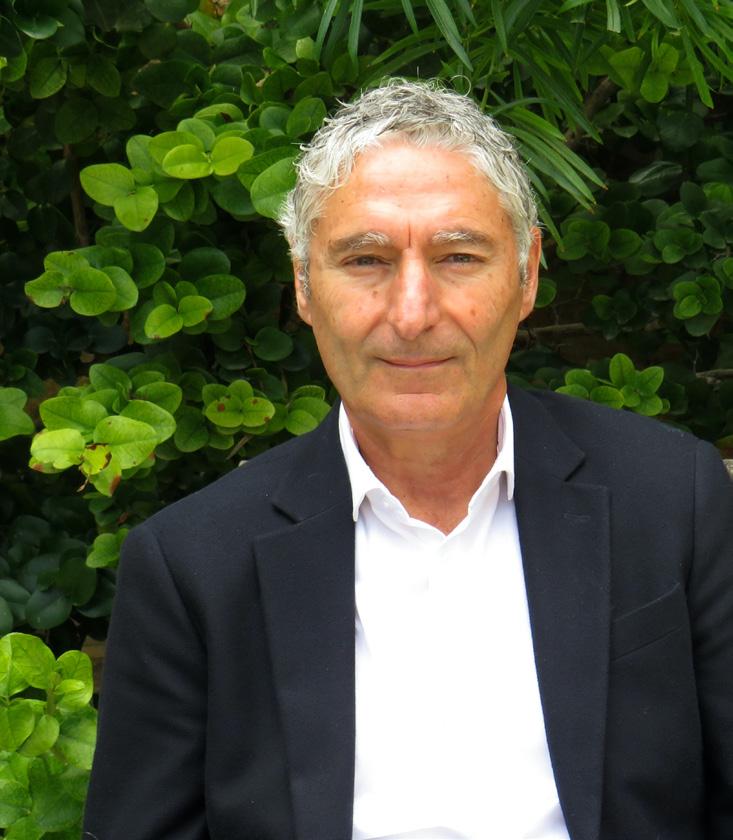
ISSUE 80 MONEY 28 NGO

WORKING NOW... TO PROTECT TOMORROW
Vanessa Macdonald speaks to Patrick Calleja, the new president of Din l-Art Ħelwa, about his vision for Malta's urban future, the imperative of safeguarding cultural heritage, and the transformative power of sustainable architecture in the face of ongoing developmental challenges.
MONEY THE DESIGN, ARCHITECTURE & URBAN PLANNING EDITION 29 NGO
Architect Patrick Calleja, the new executive president of Din l-Art Ħelwa, is in awe of all the NGO does. Ask him about urban planning, and he raises an eyebrow as if to say, "Urban planning? What urban planning?"
"Urban planning has always been on the back burner. It tended to be seen as something the state, rather than the private sector, had to do. For a very long time, there was no urban planning; we were merely dividing up plots and passing roads through them wherever it seemed convenient. Now we are seeing the results of this approach, with traffic gridlocks, new roads being dug up everywhere, a lack of public space, and so on.
"The best way to demonstrate it is by showing an example of where urban planning can improve things, such as in Cottonera and the Three Cities. There are large public areas that can cope with the commercialisation. These were opened up when the dockyard walls were taken down. There has been a real improvement in the area, and it just shows what can be done with good planning," he said.
Patrick has been on the jury for the Din l-Art Ħelwa and Kamra tal-Periti architectural awards a few times, and he sees glimmers of hope for the future.
"Over the past decade, there has been a great improvement in certain design sectors, particularly when it comes to private projects. In the competitions, you can see great ideas and interesting designs. And not only from one or two firms but also from new and younger ones," he said, praising the creativity and passion that were obvious from their work.
He expressed sympathy for the time that planning-related bureaucracy took, saying that these tedious tasks were frequently very frustrating. In addition, he worries that the current policies do not always encourage good design.
Urban planning? What urban planning? We've been dividing plots without a true vision for too long.
"Policies tend to be more about building codes than about setting high standards: there is nothing there that promotes good design," he lamented.
"Local Plans are more of a policy for land use, although they are not always adhered to! There is all too often commercial use in areas where this was banned by the Local Plan." He was clearly unhappy with some of the decisions the Planning Authority took. Din l-Art Ħelwa's Heritage and Environment Protection Committee submitted at least 850 objections in 2023 to applications that were either in breach of policy or would have a negative impact on cultural heritage, the environment or our urban landscape.
Some examples are:
» The continued practice of converting a 2-room shack into a 150-square-metre villa in the countryside.
» Dozens of dubious requests for stables and sheep farms across the Maltese and Gozitan rural areas.
» Requests for 10 to 12-storey hotels in predominantly residential areas.
» Towering apartment blocks threaten the integrity of historic cores (urban conservation areas) or protected skylines.
» Excessive development of or around listed properties or monuments.
Din l-Art Ħelwa more than doubled its 2022 efforts and, in 2023, filed 27 new appeals before the Environment and Planning Review Tribunal, seeking to overturn developments across Malta and Gozo. The HEP team was successful in many cases, setting case law precedents that will shape applications in the future. But it also lost some cases, against all odds, which went as far as the courts.
One aspect of concern that he singled out is development in urban conservation areas, which he said deserved far more protection. "Let me give you an example: there is one case of a beautiful farmhouse in a valley. There is an application to have it demolished and to build five villas instead. Why should the PA allow this? Why not convert it to a modern dwelling with a garden and lovely fields around it? It cannot all be about money!"
He shook his head at the disruption of streetscapes in areas from Pembroke to Tarxien.
ISSUE 80 MONEY 30 NGO
"You have a beautiful terraced area of twostorey houses, and someone has built a five-storey block in the middle of them! The Local Plans established how many floors could be built in that area. They highlighted that this was important not only because of the height per se but also because of the intensity of development, including the impact on the infrastructure, from drainage and water to traffic and parking," he said.
Apart from the streetscapes, developments have destroyed many of the long-distance views of urban conservation areas, he said, noting that in some cases, you can no longer even see the church that once used to dominate villages' horizons.
He explained that it also impacts the appetite to live in UCAs, especially regarding their boundaries.
"Imagine if you have a house at the limit of a UCA with a lovely garden around it surrounded by a rubble wall, and they build a five-storey on the other side of it, overlooking the garden. It ruins the whole point! No wonder it puts people off the whole idea of buying in a UCA as they cannot guarantee what will happen beyond their walls," he said, adding that the solution proposed had been to have arched windows in the new building overlooking the garden.
"Is that the solution? It is absurd!"
For many years, the Din l-Art Ħelwa rallying cry has been 'Stop the Greed'. Patrick pointed out that since property had become so expensive, it had become the norm for people to drop their houses and replace them with flats to give their kids, noting that they could sell just one flat and pay for the whole development.
So, who should lead the drive to quality instead of quantity? He lamented that the architects from the university did not have the confidence to challenge their clients.
"Who is going to look at the bigger picture, the long term, instead of the short term," he asked.
He wants to continue the crucial work that Din l-Art Ħelwa, which will celebrate its 60th anniversary next year, does through its HEP team and its enormous maintenance and restoration work at historic sites. It currently holds nearly a score of sites under
Stop the greed. We need to focus on quality, not just quantity, in our developments.
guardianship, raising hundreds of thousands of euros in funds to pay for it all, as well as opening numerous sites to the public. The army of over 200 volunteers welcomed 136,000 visitors last year, nearly double the previous year's total. And 236 events were organised, including corporate funds, donations and memberships.
He is in awe of the time volunteers dedicate so freely, adding that he came from a profession where you charge for everything. He has already started visiting all the sites and is beginning to develop his vision for Din l-Art Ħelwa, which he will present to the Council.
"The time might have come to consolidate the sites and standardise the presentations at all of them... Another task will be planning for succession and roping in a younger generation. I recently watched a presentation by one of the young volunteers from the Msida Bastion Garden and Cemetery and was so impressed. That is the sort of energy that we need to harvest to rope in the next generation."
Patrick had already planned to start winding down his architectural practice office in 2024, focusing on completing what he was already working on rather than taking on new projects.
"The opportunity to take over from former president Alex Torpiano came at a great moment. It was not something that I was expecting, but when approached, it clearly fitted in very well with my personal plans, as I want to take up something more meaningful to replace my work. Being part of the Din l-Art Ħelwa team is a great honour and privilege; I have a lot of respect for the NGO as an institution.
"Now it is my time to give back as much as possible, not just to Din l-Art Ħelwa but to Malta!"
MONEY THE DESIGN, ARCHITECTURE & URBAN PLANNING EDITION 31 NGO
BRIDGING NATURE AND URBANISATION

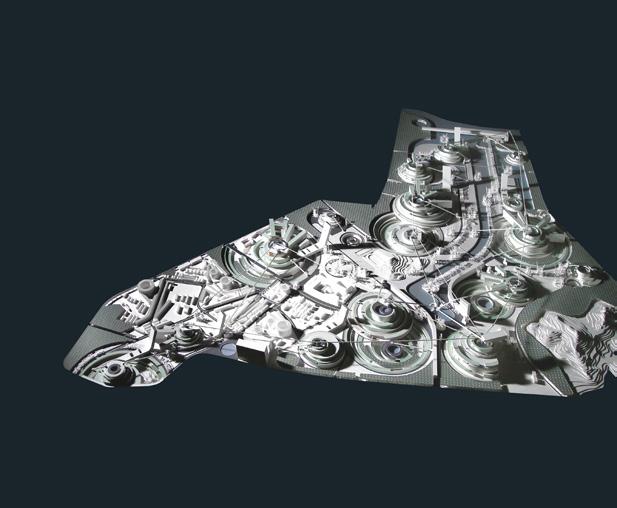
In the glorious setting of the Auberge de Provence, adorned with neo-Pompeian murals and a profusion of floral decorations, the Malta International Contemporary Arts Space (MICAS) hosted the 'Connecting with Nature' conference last autumn. Konrad Buhagiar delves into the discussions held against a backdrop symbolising a deepseated reverence for nature, convening experts and enthusiasts to explore the human imperative to reconnect with the natural world amidst the challenges of burgeoning urban populations and escalating urbanisation.
ISSUE 80 MONEY 32 URBANISM
Last autumn, MICAS (Malta International Contemporary Arts Space) organised a conference entitled Connecting with Nature that was held against the backdrop of a profusion of wreaths and garlands of flowers, articulating the neo-Pompeian wall paintings of the main hall of the Auberge de Provence. The space provided the ideal context for a discussion on the human need to connect with nature at a time when more than half of the globe's population, around 4.2 billion people, live in urban areas. This strident phenomenon of urbanisation has had its effect on a micro level and close to home, as well.
Malta, for example, has seen a remarkable population surge over the past decade, with a 25% increase, the highest in Europe. Consequently, construction output on the island has skyrocketed, quadrupling over the last twenty years, marking Europe's most rapid growth rate.
Nature has always been coveted everywhere and included as a necessary ingredient in architecture, town planning, urban regeneration, housing development and public recreation.
While the walls of the Auberge de Provence reflect a longstanding appreciation for nature's therapeutic benefits, in a world witnessing
In a world witnessing exponential population growth... modern concerns extend beyond seeking solace in nature.
exponential population growth (expected to reach ten billion by 2050), modern concerns extend beyond seeking solace in nature.
Today, the focus is on addressing the broader challenges of urbanisation and ensuring nature's role transcends mere aesthetic balance in our increasingly complex artificial cityscapes.
The world's economic order, which is based on capital accumulation with little to no consideration of the ensuing decline in social well-being and employment and the resulting division of society into an excessively privileged dominant class and the dispossessed, is sidestepping demands that have doubled due to rampant population growth. Add to this a global food crisis and climate change, and we risk seeing 'a global decline into a chaotic world ruled by brutal warlords on devastated earth,' as James Lovelock, author of The Revenge of Gaia: Why the Earth is Fighting Back and How We Can Still Save Humanity, prophesied in 2006.
The harrowing scenes of devastation in the Gaza Strip spring to mind, serving as an ominous warning of the nefarious turns and sinister consequences that the hitherto trusted and trustworthy world order has engendered. →
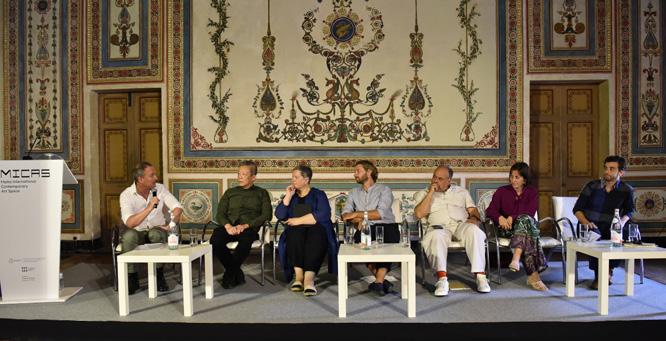
MONEY THE DESIGN, ARCHITECTURE & URBAN PLANNING EDITION 33 URBANISM
CJ Lim, the keynote speaker at the conference, is a celebrated urban planner and professor of architecture and urbanism at Bartlett University College in London. In his writings and his lectures, his mission has been to tackle the most significant issues of the 21st century: the loss of agricultural land, climate change, a ballooning population, and the need to consider food security as a priority. In his 2019 book Smart Cities, Resilient Landscapes and Eco-Warriors, he builds on the work of contemporary architects who incorporate sustainability principles in their design of discrete buildings, including elements such as passive climate control, greywater recycling, green roofs, and renewable energy collection. But he is also vocal about the next big step required if global issues are to be resolved effectively. This giant recalibration of how we do things entails a radically different approach that turns to the city, an organism infinitely more complex than the individual building, to create a framework that supports synergistic human-made and natural systems working together.
According to him, Richard Rogers has advocated for efficient communal transportation in this "smart city." Waste
CJ Lim advocates for a radically different approach...
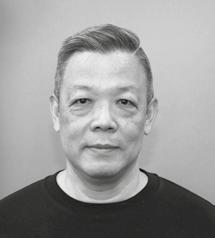
products are recycled and reused in the city and not elsewhere outside its confines. Land use is zoned both vertically and horizontally. Resilient landscapes are implemented in the city's centre, supporting urban agriculture and energy generation on a meaningful scale. Public space is conceived and designed to promote social inclusion. In a nutshell, an urban infrastructure free from the hegemony of the motor car will generate and manifest a spatial fabric different from that of the contemporary metropolis.
In his utopian novel News from Nowhere, William Morris described cities' aesthetic and commercial potential by juxtaposing pastoral and urban infrastructures. This is a precursor of Professor Lim's description of the smart city. Nature is central to his vision. He positions farming in the town not only as a form of survival of the arcadian myth of open paradisiacal green spaces but as an enabler of a Soil to Table manifesto, spaces where growing food for oneself is part of a daily
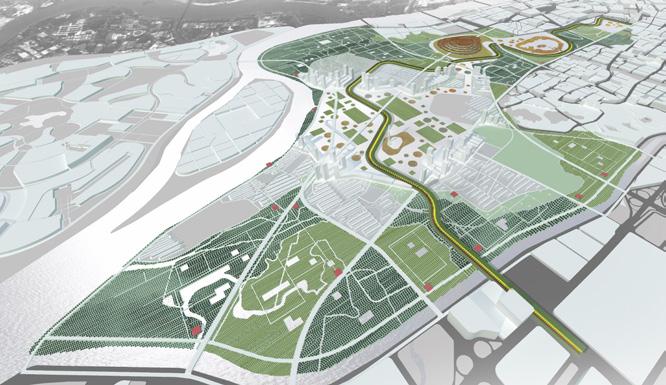
ISSUE 80 MONEY 34 URBANISM
CJ Lim's Smartcity China
CJ Lim's Smartcity South Korea

routine, a habit that in many cities is a longestablished tradition among the affluent and the underprivileged alike. This re-engagement with the roots of our sustenance can have many positive benefits for the community. Besides eliminating the dependency on vacuum-sealed or frozen meals that come from far away and have a considerable carbon footprint, food distribution within the city will require less transport and preservation times and less need for preservatives, growth hormones and pesticides. The consequent health benefits, community engagement and reestablishment of food production as a relationship with society rather than an abstract commercial commodity cannot be underestimated.
Developing a robust infrastructure for water management, encompassing water drainage, harvesting, organic waste recycling, traditional crop rotation, and preserving nutrient-rich soils, will enhance urban operations and functions. In the new cities in China, for whose master plan Professor Lim has been responsible, this method allows the possibility of preserving the authentic social fabric of the area by eliminating the need for the painful displacement of old farming communities settled on the land for millennia.
Finally, Professor Lim showed us, with the help of images, how scale and context can affect beauty. "A cabbage or wheat patch is not as conventionally beautiful as daffodils or tulips, but when scaled up, replicated a thousandfold, reconfigured into vertical surfaces, or arrayed
into patterns—in short, curated—they can achieve the elegance of multi-sensory art and expand the limited palette of urban textures. In the smart city, buildings and roofscapes will transform in colour, volume, and scent through the seasons."
...to create a framework that supports synergistic human-made and natural systems working together.
The smart city of the future is underpinned by the scientific data necessary to render its innovative urban master plans credible. Still, it is a dream nonetheless, no different from Laparelli's dream of a new city on the peninsula of Mount Sciberras five hundred years ago. That, too, was a smart city ante litteram, equipped with sophisticated systems of drainage and water collection, luscious gardens and orange groves planted on its bastions and in its ditches, underground grain storage silos, and windmills on its most exposed sites for the harvesting of wind energy.
Professor Lim's suggestive storytelling was captivating. After the conference adjourned, we felt compelled to linger for a while in the cool, floral-themed interior of the Auberge de Provence, reluctant to reemerge into the bustling chaos and the ruthlessly callous and exploitative commercialism of the capital city outside.
MONEY THE DESIGN, ARCHITECTURE & URBAN PLANNING EDITION 35 URBANISM
Smart Malta
The Road to Transformative Localities
JP Fabri discusses Malta's journey towards becoming a smart locality, which showcases how integrating innovative technologies can transform local communities. Focusing on economic growth, improved public services, and enhanced quality of life, this visionary approach highlights the universal benefits of smart cities, even in smaller communities like Malta.
In an era of rapid technological advancement and urbanisation, smart cities have emerged as a beacon of progress, promising enhanced efficiency, sustainability, and quality of life for residents. While the term "smart city" often conjures images of sprawling metropolises, the benefits of smart technologies are equally applicable to smaller communities. In the case of Malta, implementing smart localities presents a transformative opportunity to bolster economic growth, improve public services, ensure effective enforcement, and enhance overall well-being.
Understanding smart localities
Smart localities encompass integrating innovative technologies and data-driven approaches to optimise various aspects of urban life within a specific community. These technologies range from IoT (Internet of Things) sensors and data analytics to AI-powered systems and digital platforms, all aimed at enhancing connectivity, resource management, and citizen engagement. The core principles of smart localities revolve around sustainability, efficiency, and inclusivity, fostering environments where residents can thrive economically and socially.
Smart localities leverage a wide array of technologies to achieve their objectives. For instance, IoT sensors embedded in infrastructure and public spaces collect real-time data on traffic flow, air quality, and energy consumption. This data is then analysed to identify patterns and trends, enabling authorities to make informed decisions regarding resource allocation and service provision. Additionally, digital platforms and mobile applications facilitate citizen participation by allowing the residents to report issues, access information, and engage with local government.
Economic opportunities
The economic benefits of embracing smart localisation strategies are manifold. By leveraging technology to streamline processes and infrastructure, local businesses can operate more efficiently,

increasing productivity and competitiveness. For example, smart transportation systems can optimise routes and schedules, reducing logistics companies' fuel consumption and operational costs. Similarly, digital marketing platforms and e-commerce solutions enable small businesses to reach a broader customer base and compete with larger enterprises on a level playing field.
Moreover, implementing smart solutions attracts investment and fosters innovation, positioning Malta as a technological advancement and entrepreneurship hub. Investors are drawn to smart localities due to their reputation for efficiency, sustainability, and quality of life, creating opportunities for economic growth and job creation. Furthermore, collaboration between the public and private sectors stimulates
ISSUE 80 MONEY 36
INNOVATION
innovation and the development of new technologies, driving economic diversification and long-term prosperity.
Enhancing public services
Central to the concept of smart localities is the optimisation of public services to better meet the needs of residents. By deploying digital platforms and data analytics, local governments can deliver services more effectively, from transportation and waste management to healthcare and education. For example, Barcelona, Spain, is a prime example of a city that has successfully embraced smart urban development. The city's "Smart City Barcelona" initiative leverages technology to address various urban challenges, including traffic congestion, pollution, and energy consumption. One notable project is implementing a smart parking system, which uses sensors to monitor parking spaces in real time and provides drivers with information on available spots via a mobile application. This initiative has reduced traffic congestion and emissions and improved the overall user experience for residents and visitors.
Similarly, Amsterdam, Netherlands, has implemented innovative solutions to promote sustainability and digital innovation, earning
and address issues like crime, traffic violations, and environmental infringements. For example, London, United Kingdom, has implemented a "Smart London Plan" to leverage technology to improve public safety and security. The city's "Smart Policing" initiative utilises data analytics and predictive modelling to identify crime hotspots and allocate resources effectively. Additionally, London has deployed CCTV cameras equipped with facial recognition technology to enhance surveillance capabilities and deter criminal activity. These initiatives have contributed to a significant reduction in crime rates and improved public confidence in law enforcement.
Well-being and quality of life
At the heart of smart locality strategies lies the goal of enhancing residents' overall well-being and quality of life. By prioritising initiatives that promote health, safety, and community engagement, smart localities cultivate environments where individuals can thrive. For instance, Singapore has implemented a comprehensive "Smart Nation" initiative to leverage technology to improve its residents' quality of life. The city-state has deployed various smart solutions, including healthcare monitoring systems, smart homes, and digital services, to enhance accessibility and convenience. Additionally, Singapore has invested in green spaces and recreational facilities to promote physical and mental well-being among its residents. These initiatives have contributed to Singapore's reputation as one of the world's most livable cities, attracting talent and investment from around the globe.
Using IoT sensors, AIpowered systems, and digital platforms, Malta aims to improve connectivity, resource management, and citizen engagement.
The vision for Malta
In Malta, the transition towards smart localities presents a unique opportunity to harness the nation's inherent strengths and address its specific challenges. With its compact size and a strong sense of community, Malta is well-positioned to implement tailored, smart solutions that cater to the needs of its residents.
Malta can chart a visionary path towards sustainable economic growth, enhanced public services, and improved well-being by engaging local councils and fostering collaboration between government, businesses, and communities. Through strategic planning, investment, and commitment to citizen-centric principles, Malta can pave the way towards a brighter future for future generations.
recognition as one of Europe's leading smart cities. The city's "Amsterdam Smart City" program focuses on energy, mobility, and circular economy, leveraging technology to achieve ambitious sustainability goals. One notable project is the development of a smart grid infrastructure, which integrates renewable energy sources and enables efficient energy distribution and management. This initiative has reduced carbon emissions and generated economic opportunities in the renewable energy sector.
Effective enforcement
Smart technologies play a crucial role in enhancing enforcement mechanisms within communities. By leveraging data analytics and surveillance systems, authorities can more efficiently monitor
The advent of smart localities heralds a new era of possibility for Malta, offering the prospect of economic prosperity, efficient public services, effective enforcement, and enhanced well-being. By embracing innovative technologies and collaborative approaches, Malta can unlock its full potential as a dynamic and sustainable nation.
Through strategic partnerships, pilot projects, and continuous evaluation, Malta can overcome challenges and seize opportunities to become innovative urban development leaders. We already have a number of companies involved in smart city projects and export their products and services, thus making Malta a very good candidate for a testbed for such smart cities. By prioritising the needs of its residents and leveraging the power of technology, Malta can build resilient, inclusive, and prosperous communities that thrive in the digital age.
MONEY THE DESIGN, ARCHITECTURE & URBAN PLANNING EDITION 37
INNOVATION

ISSUE 80 MONEY 38 TRIBUTE
Riken Yamamoto Shaping Spaces, Connecting Communities
In an era where architecture shapes societies as much as it does skylines, Riken Yamamoto's contributions are a testament to the transformative power of thoughtful design. Awarded the 2024 Pritzker Architecture Prize, Yamamoto's work transcends traditional boundaries, fostering communal interactions and integrating nature with urban life. MONEY delves into the visionary projects that underscore his commitment to creating spaces that are lived in and experienced.
Riken Yamamoto is a renowned architectural figure who has profoundly impacted contemporary society by redefining the boundaries between public and private spaces. In recognition of his innovative, environmentally conscious, and community-engaged work, he was awarded the prestigious Pritzker Architecture Prize in 2024.
Yamamoto's architectural designs offer shelter and catalyse community interaction and cultural integration, showcasing his visionary approach that merges architectural form with social function. His work has transcended geographical boundaries and cultural differences, leaving an indelible mark on the cities that his projects inhabit. His projects have influenced generations of architects and urban planners worldwide, from private residences to public institutions and large-scale urban developments. The Pritzker Architecture Prize, often described as the Nobel Prize of architecture, celebrates his lifetime of work and contribution to the field.
Revamping city living: A fresh take on community spaces
Yamamoto's philosophy centres around "sharing one space," where architectural design fosters community among inhabitants. This ethos is vividly reflected in the Pangyo Housing project in Seongnam, South Korea, where low-rise blocks and transparent ground floors promote
interconnectedness among neighbours, challenging traditional notions of privacy. Similarly, the Fussa City Hall in Tokyo, with its inviting architecture and public spaces, →
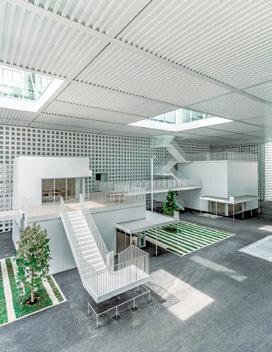 Nagoya Zokei University
Nagoya Zokei University
MONEY THE DESIGN, ARCHITECTURE & URBAN PLANNING EDITION 39
TRIBUTE
exemplifies how civic buildings can harmonise with their surroundings and encourage public engagement
Harmonising with nature: Yokosuka Museum of Art
The Yokosuka Museum of Art in Japan exemplifies Yamamoto's ability to integrate architecture with nature. Its design, featuring a snaking entrance that mirrors the surrounding bay, mountains, and extensive underground exhibition spaces, provides undisturbed landscape views, blending art with environmental beauty. This project highlights Yamamoto's skill in creating spaces that respect and enhance their natural settings, providing visitors with a serene and immersive experience.
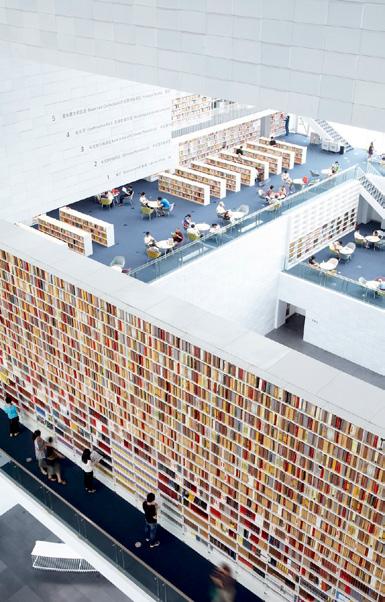
In the Tianjin Library, Yamamoto crafts
a cultural icon that is as much a beacon of learning as an architectural marvel.
Educational environments: Fostering learning and interaction
Yamamoto's work on educational facilities like Nagoya Zokei University and Koyasu Elementary School underscores his commitment to fostering environments that promote learning and social interaction. At Nagoya Zokei University, there is ample open space on the top floor, and the studio is flexible, encouraging collaboration among students from different disciplines. The latticed facade allows natural light to permeate, creating a welcoming atmosphere. The Koyasu Elementary School's gridded structure and classrooms that open onto large terraces maximise opportunities for students to interact and engage with their surroundings.
ISSUE 80 MONEY 40
TRIBUTE
Tianjin Library

Cultural
The Tianjin Library in China stands as a testament to Yamamoto's vision of creating cultural icons that serve the community while pushing the boundaries of design. Housing six million books within a vast 55,000-squaremetre space, the library features crisscrossing levels and a stone-louvered facade that protects against dust storms. This showcases Yamamoto's innovative approach to tackling environmental challenges while creating stimulating public spaces
Architectural philosophy: Blurring boundaries
At the core of Yamamoto's architectural philosophy is blurring the boundaries between public and private spaces to create areas that facilitate social interactions and foster community. This approach is evident in his housing projects, civic buildings like Fussa City Hall, and educational institutions like Saitama Prefectural University. By designing spaces encouraging people to unite, Yamamoto contributes to building harmonious societies where architecture serves as a backdrop to everyday life .
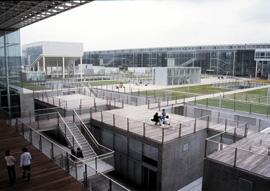
Sustainability and environmental consideration
Yamamoto's projects also reflect a solid commitment to sustainability and environmental consideration. His work creates a more sustainable and livable urban environment by integrating buildings with their natural surroundings

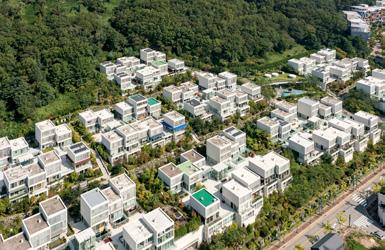
and using materials and designs that minimise ecological impact. This approach enhances the aesthetic appeal of his projects and ensures they are sustainable and resilient in the face of environmental challenges
Riken Yamamoto's architectural legacy is characterised by his visionary approach to creating spaces that enhance human interactions, integrate with nature, and promote community cohesion. Through his innovative designs and philosophical insights, Yamamoto has redefined the role of architecture in contemporary society, demonstrating that buildings can be more than just physical structures—they can be the heart of communities, facilitating connections and fostering a sense of belonging. His work is a testament to his architectural genius and a beacon for future generations seeking to create more inclusive, sustainable, and vibrant urban spaces.
MONEY THE DESIGN, ARCHITECTURE & URBAN PLANNING EDITION 41 TRIBUTE
icons: Tianjin Library
Fussa City Hall in Tokyo
Saitama Prefectural University
Yokosuka Museum of Art
Pangyo Housing

ELEVATING THE JOURNEY
The Land Rover Defender's Architectural Mastery
Introducing the Land Rover Defender, a seamless fusion of contemporary technology with timeless design. More than a vehicle, the Defender is a physical representation of architectural precision, innovative design, and luxury.
ISSUE 80 MONEY 42 PROMO
Every line, curve, and detail of the Defender is carefully crafted, reflecting the robust beauty of modern architecture. Architects integrate space, light, and structure to create functional and visually pleasing buildings, and the Land Rover Defender incorporates the same principles in its design, offering a driving experience that is as comfortable as it is visually appealing.
The interior design of the Defender embodies modern minimalism, with every element purposefully chosen and positioned. Each component harmonises to create a space that is not only functional but also radiates luxury and comfort. The plush seating, intuitive dashboard layout, and every detail within the Defender are designed with the driver's comfort and convenience in mind.
The exterior of the Land Rover Defender is equally impressive. Its striking silhouette, adorned with bold, confident lines, encapsulates the essence of modern automotive design. The streamlined shape enhances its visual appeal and improves its aerodynamic performance, ensuring smooth, efficient driving in city or off-road terrain.
In every sense, the Land Rover Defender is a marvel of modern design, setting a new bar for luxury SUVs. It's more than a vehicle; it's a bold statement of architectural precision and innovative design's potential in the automotive industry.
Further, the Land Rover Defender's performance is just as impressive as its design. It has a powerful engine that delivers exceptional horsepower and torque, making it a capable performer on any terrain. The advanced suspension system provides a smooth ride, and the responsive steering ensures precise control on winding roads and tight corners. The Land Rover Defender also prioritises safety, boasting a comprehensive suite of advanced safety features. These include adaptive cruise control, automatic emergency braking, and a surroundview camera system, providing drivers with enhanced control and peace of mind. The Defender's rugged construction and advanced safety systems work together to deliver an SUV that is as safe as it is stylish.
The Defender is also equipped with state-of-the-art infotainment technology. The touchscreen interface is intuitive and responsive, providing easy access to navigation, music, and vehicle settings.


Every line, curve, and detail of the Defender is meticulously crafted, embodying the robust elegance of contemporary architecture.
Wireless charging and multiple USB ports ensure that all devices stay powered up on the go.
In conclusion, the Land Rover Defender is an extraordinary blend of style, performance, and technology. It sets a new standard in the luxury SUV category, offering a driving experience as compelling as its design. The Defender is more than just a vehicle; it's a tangible testament to the possibilities of innovative design and architectural precision in the automotive world. Its presence on the road makes a statement, reflecting its driver's sophisticated taste and discerning eye.
MONEY THE DESIGN, ARCHITECTURE & URBAN PLANNING EDITION 43 PROMO
The ‘S’ Factor

In the shifting real estate industry, sustainability goes beyond the environment to embrace social values, the 'S' in ESG. Nicole Grima explores this vital yet under-appreciated aspect, showing how diversity, equity, and inclusion (DEI) in projects enhance community well-being and advance the sector's goals for net zero and sustainability.
What does the S mean when it comes to real estate?
Accelerating the transition to net zero is paramount in the real estate industry. However, this must be coupled with a broader commitment to sustainable development goals to ensure holistic progress.
Companies have turned to ESG (Environmental, Social, and Governance) reporting to focus their efforts and benchmark their progress on these three pillars, which are considered mutually essential for sustainable and responsible business practices. However, as of now, the social aspect, denoted by the 'S' in ESG, can sometimes take a backseat, overpowered by the more familiar and
approachable environmental aspect, the 'E' pillar.
However, recognising and addressing social value is crucial for creating lasting positive impacts within communities across the real estate life cycle and is often less costly to achieve if tackled from the start of a project.
The 'S' is all about how our real estate investments fit into the overall fabric of a community. It addresses the four scopes of social value listed below (within the framework of the World Green Building Council, which aims to identify and outline key social considerations related to the building and construction life-cycle) alongside their environmental and governance goals.
ISSUE 80 MONEY 44 INCLUSIVE
The business case for DEI
One key consideration here is diversity, equity, and inclusion (DEI), which has evolved into a dynamic force reshaping the corporate landscape. DEI is also integral to achieving the United Nations Sustainable Development Goals (SDGs), particularly goals 5 and 10, which address gender equality and reduced inequality. DEI is also crucial in addressing scopes 0, 1, and 2 (listed above).
Numerous studies strongly support the business case for Diversity, Equity, and Inclusion (DEI). These studies demonstrate that organisations with a diverse workforce not only operate more effectively and efficiently but also gain credibility and a deeper understanding of the issues faced by diverse communities. These organisations foster an environment of creativity and innovation, essential in attracting and retaining top talent. Moreover, they often financially outperform their peers, showcasing the tangible benefits of investing in DEI initiatives.
DEI is more than just accessibility
In its 2024 definition, the Royal Institution of Chartered Surveyors (RICS) articulates Diversity, Equity, and Inclusion (DEI) with a comprehensive approach. Diversity is seen as
the essence of humanity, encompassing a vast array of characteristics from skin colour, education, and religious beliefs to value systems, with some traits being visible and others less so, indicating that much of an individual's identity is not immediately apparent. Equity is recognised for acknowledging that not every employee has had equal opportunities, either in their upbringing or as they entered the workforce, and it aims to correct these disparities by providing the necessary tools and support for everyone to achieve their potential, irrespective of their starting point. Inclusion is a deliberate aspect of workplace culture, involving the decision to include or exclude people from conversations, projects, or events to foster an environment where people feel comfortable expressing their entire selves through positive, inclusive actions.
DEI, therefore, encompasses far more than accessibility, which tends to be the primary focus for many individuals. While accessibility endeavours to eliminate physical barriers, DEI initiatives strive to establish fair and inclusive environments, nurturing a sense of belonging and acceptance for everyone involved.
It is crucial to understand that DEI and accessibility are interconnected pursuits rooted in a collective aspiration for fairness, belonging, and inclusivity. Advocating for → SCOPE
Examples:
» Ethical leadership
» Employee health, working conditions and satisfaction
» Stakeholder engagement
» Corporate governance
Examples:
» Housing attainability and habitability
» Indoor environmental quality
» Climate change impacts and adaptation measures
Examples:
» Accessibility
» Just transition
» Community protection and empowerment
Examples:
» Environmental risks
» Sustainable construction
» Transparency and auditing
» Labour rights
Examples include: Diversity and inclusion; Health, Comfort and Safety; Privacy and Security; Climate Impacts
MONEY THE DESIGN, ARCHITECTURE & URBAN PLANNING EDITION 45
INCLUSIVE
0 Entity & Internal Practices
Scopes of Social Impact for the Built Environment
1 Building Users & Site SCOPE 2 Community & Surroundings SCOPE 3 Supply & Value Chains
Four
SCOPE
Social Impact and Considerations Across All Scopes
Building
Life Cycle OPERATIONAL DESIGN & CONSTRUCTION MANUFACTURING & END OF LIFE
& Construction
accessibility inherently involves advocating for DEI and vice versa. This underscores the significance of seamlessly integrating accessibility into broader diversity initiatives.
DEI in Malta
DEI is not new; however, its significance surged in 2020 amidst the COVID-19 pandemic and the tragic case of George Floyd. These events sparked a monumental shift in values among businesses, leading to heightened awareness and a newfound emphasis on social initiatives related to DEI.
In Malta, there is a growing acknowledgment of DEI's significance. Some recent initiatives include the introduction of the 'Malta Diversity and Inclusion Charter' by the CORE Platform and collaborations between organisations like the Malta Chamber of Commerce, Enterprise and Industry, and Allied Rainbow Communities (ARC), which aim to promote DEI in the workplace.
However, awareness and action on DEI in Malta still primarily focus on the firm's internal practices (i.e. scope 0), with less attention given to the social impact of the built environment (scopes 1 and 2).
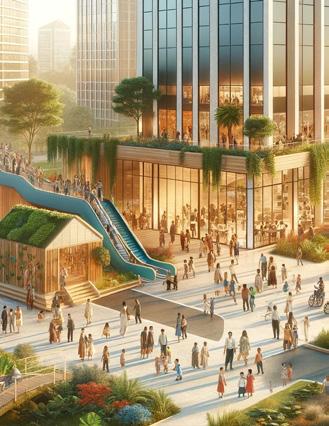
How design supports your DEI initiatives
Designing for DEI in scopes 1 and 2 is critical for a successful DEI strategy. This is easier said than done, as inclusive design for a building's direct users and surrounding community extends beyond addressing obvious physical barriers for those with mobility difficulties. It also encompasses considerations for all genders, ages, and races, disabilities such as vision or hearing impairments, conditions causing chronic fatigue, and cognitive disabilities. We can foster greater inclusivity in the built environment by recognising and addressing diverse needs.
Failure to prioritise DEI within a building could result in a negative experience for individuals with disabilities, leading to reputational damage, legal repercussions, or costly retroactive modifications such as relocating fixtures or modifying pathways. Proactively addressing - DEI concerns is not only ethically imperative but also financially prudent.
DEI design features
Inclusive design features in office environments prioritise accessibility and comfort for all users, catering to their
Real estate's social value transcends mere construction; it embodies the essence of community integration and sustainable development.
ISSUE 80 MONEY 46 INCLUSIVE

diverse needs. Key considerations include ensuring the building adheres to accessibility standards with features like ramps, elevators, and accessible restrooms, enabling effortless navigation for those with mobility challenges. Flexible spaces are essential to accommodate different working styles, from quiet areas for focused tasks to collaborative zones and open spaces for brainstorming. Investing in ergonomic furniture, such as adjustable desks and chairs, supports users of varying physical abilities. Additionally, attention to sensory considerations is critical, with thoughtful design around noise levels, lighting, and visual distractions to create a comfortable and productive space for everyone. Incorporating diverse artwork and decor reflecting various cultures and perspectives further enhances the inclusivity of the office environment.
How to design for DEI
At the heart of DEI by design lie three fundamental principles aimed at creating welcoming and inclusive spaces for everyone. Firstly, prioritising the needs of people from the beginning is essential, and incorporating inclusive design principles early in the planning process can often be achieved without additional costs.
Secondly, it's crucial to engage with accessibility and DEI design consultants who can assess various aspects of the site's design, including its layout, pathways, material selection, and the strategic placement of amenities such as seating and planters.
Thirdly, a collaborative approach that includes feedback
from diverse perspectives is vital. Designing with the disability community rather than for it ensures that the lived experiences of individuals with disabilities are listened to and valued, which is critical to creating a built environment that is genuinely inclusive.
In conclusion, the exploration of DEI in real estate design underscores its paramount importance in creating truly sustainable and inclusive environments. As we navigate the complexities of the built environment, it is imperative to recognise the interconnectedness of DEI with ESG practices. By embracing DEI as a guiding principle in our approach to design and development, we not only enhance the social value of our projects but also foster environments that are welcoming, accessible, and empowering for all individuals.
As we move forward, organisations and individuals must integrate DEI into every facet of the design process, from inception to implementation. By listening to and valuing the lived experiences of diverse communities, collaborating with accessibility and DEI consultants, and embedding inclusive design principles into our projects, we can create environments that reflect all individuals' diverse needs and identities.
Ultimately, the journey toward DEI in design is ongoing and requires continuous commitment and action. By embracing DEI as an integral part of our values and operations, we unlock the true potential of our projects, paving the way for a brighter, more inclusive future for all.
MONEY THE DESIGN, ARCHITECTURE & URBAN PLANNING EDITION 47 INCLUSIVE
MALTA’S CROSSROADS
The Urgent Need for Sustainable Urban Planning

David Grima highlights the critical role of urban design in enhancing well-being and economic prosperity. As he reflects on his observations from Western countries and contrasts them with Malta's oversight in urban planning, he argues for the transformative power of green spaces, quality infrastructure, and thoughtful urban layouts to improve life quality and support tourism, urging Malta to prioritise its natural and urban landscapes for the future.
Urban design has been given increasingly more prominence over the years in many Western countries. Even during a recent trip to London, I couldn't help but notice how many green areas have been added along busy thoroughfares. The importance of public spaces, green areas, good quality roads, etc., has been found to contribute directly to a person's well-being and the general economy.
Urban planning is an issue that has often been overlooked in Malta. Politicians often underestimate its effect on one's mental well-being and quality of life, besides hitting the tourism sector. As a country, we are blessed with beautiful landscapes and very picturesque natural areas, but our man-made environment has been somewhat lacking. As Maltese, we tend to focus on our homes and their cleanliness but rarely consider outdoor common areas. We underestimate the benefits of a pleasant stroll along the coast, a lovely picnic in a green area, or sunbathing at a well-kept beach. Although most towns are abundant with coffee shops and outdoor seating areas, we don't care what the surrounding areas consist of. Short-
Short-term fixes and greed have superseded the well-being of residents, denying suitable outdoor spaces for all ages.
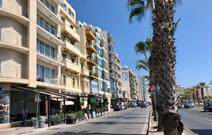
term fixes and greed have superseded the residents' well-being, denying our younger and older alike suitable outdoor places and facilities to enjoy. Urban planning has been completely sidestepped and is given little to no importance. It is clear that many decisions are being taken by officials who offer no second thought or consideration for the environment.
A clear example is Gzira (Fig.1) where the main road has been adorned with outdoor seating, but there is little apart from cars and pollution. Imagine if the pavement had been wider, allowing more room for pedestrians and a less suffocating seating area. This is not to mention the entire shabbiness of the area, which is ironic as a lot of money was recently spent on
ISSUE 80 MONEY 48 URBAN PLANNING
Fig.1: Picture of Gzira Seafront
a well-designed lido, which unfortunately is surrounded by substandard infrastructure.
Another clear example is St. Julians (Fig.2) where hundreds of millions of euros have been spent on tremendous developments with high-end finishing used throughout. Yet, the infrastructure is crying out for help. An excellent way to start is to organise traffic into one-way systems, which would minimise chaos and congestion. I have always wondered why so many of our roads are two-way. Also, by organising traffic and narrowing roads, one would expect more extensive pavements, green areas and pedestrianised zones. Imagine how nice the entrance into Paceville would
look with large pavements and trees adorning the area.
For people to be attracted to an area, we can't expect to imprison them in the hotel and hope they don't wander off. Many larger developments have been designed this way, with underground car parks, shops, and restaurants. Bay Street and Mercury Towers (Fig.3) spring to mind, as I often chuckle to myself that the developments are at a completely different wavelength from the immediate surrounding infrastructure. However, it is also abundantly clear that many of the more significant developments in this area intentionally offer various services, too,


and most are within walking distance from each other. Therefore, this area should be designed to be of a quality on par with the development.
When visiting the area, one could easily watch a film at one complex, eat at another and shop at another. These developments could and should supplement each other, but for this to happen, the streets leading to the complexes should be attractive and encourage pedestrians, not vice versa. For example, the stairs leading to Paceville (Fig.4) should be spruced up, and power washed three times daily.
Sliema Ferries is another clear example of an area that has yet to receive a decent upgrade in my lifetime, at least and is in shambles.
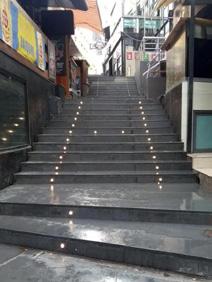
Although half-baked proposals were proposed, they were never taken seriously. I imagine a wholly pedestrianised seafront like that on the French Riviera (Fig.5). Tourists would be gobsmacked.
Valletta was given a tremendous uplift over the last 15 years. Still, unfortunately, it is now starting to suffer from a lack of maintenance and regular upkeep, such that residents complain that it has become filthy. As a frequent visitor, I must concur, as pigeon droppings and oil stains adorn most of the roads, while certain roads are either full of broken tiles or have even started to settle considerably.
The design of towns and villages should be given prominence, as it will undoubtedly result in an economic boost to the locations. Good infrastructure and beautiful outdoor surroundings are essential for any modern city and country.

MONEY THE DESIGN, ARCHITECTURE & URBAN PLANNING EDITION 49 URBAN PLANNING
Fig.5: French Riviera (Source: frenchriviera.travel)
Fig.3: Mercury Towers render
Fig.4: The Paceville stairs (Source: Wikiloc)
Fig.2: An old photo depicting the main St. Julian's Road, though everything has stayed the same and its upkeep has degraded (Source: Wikimedia Commons)
Before the next economic model
Manuel Delia delves into Malta's economic evolution in his thought-provoking piece, questioning the entrenched belief that politics is negligible in shaping economies. Tracing Malta's journey from a strategic colonial outpost to a modern economic player, he explores the island's adaptive strategies amidst global shifts, underscoring the critical need for visionary leadership in forging a sustainable and inclusive economic future.
It is almost dogmatic to say that politics cannot do much about the economy. Since the neo-con days of the 1980s, the generally accepted maxim is that the less politicians do, the better the economy is likely to fare.
As the phrase "new economic model" is dropped ever more frequently into the conversation, given the general dissatisfaction with, and concerns about the sustainability of, the incumbent model, the question begs itself. Who would imagine what the new economic model could be in reality if not for politicians? Are we hostages to fortune? Do we wait for the new model to happen to us only to make the best out of chance, or do we, as a community on a small bunch of islands, have any agency in dreaming our future into existence?
We've been at a crossroads before. Leave aside romantic narratives of the counter-revolution during the brief occupation by the French republican guard, Malta's economy has indeed been what colonial masters made of it. In modern times, it prospered in piracy and military construction, in refuelling and repairing a global navy, and in tending to the wounded in major conflicts. And it starved on the long peaceful lulls between wars when its vocation as a fortress was surplus to colonial requirements.
The country's independence promised to change that, to assert our leaders' authority to design autonomous economic activities concerned only with satisfying domestic interests. This was the 1960s when planning an economy from a minister's desk was still deemed desirable. Tourism and manufacturing would draw workers away from military redundancies.
In the 1970s, moderate economic planning gave way to iron curtain 5-year plans. The masses of unemployed were rounded up in militarised labour corps. Navy installations were converted into hotbeds of soviet
neo-industrialisation. Consumption was engineered, substituting imported goods with locally produced imitations. What needed to be imported was purchased centrally, "in bulk," as they called it, to benefit from the economies of scale of government control.
Predictably, an economy so controlled ground to a halt, generating depravation and consumer dissatisfaction instead of the intended equality and redistribution. Malta, in 1987, anticipated the arrival of McDonald's in Moscow. State-owned industries were wound down or privatised. Some interests were "popularised", allowing public participation in ownership but retaining sufficient fragmentation to retain a measure of government control.
And new service industries were founded by the enabling power of legislative creativity. Malta changed its tax regime to create incentives
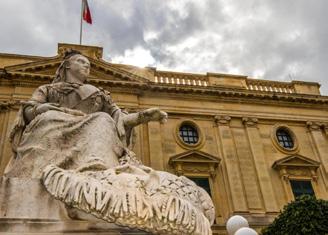
ISSUE 80 MONEY 50
POLITICS
for international businesses looking to hide in a friendly jurisdiction that at the time proudly called itself "offshore". The same logic of exceptional friendliness to overseas players dodging the heat of their own countries' bureaucracies was applied to the registration of ships, turning an administrative ledger into a money-making machine.
As the century ran out, Malta compensated for its loss of advantage in the industries of the 1960s with economic activities the 1960s could barely imagine. It became harder to find work sewing jeans and gluing soles on shoes. But if you were a lawyer or an accountant, the world became your oyster.
Meanwhile, EU membership changed the rules again. Joining a large free market was flying as far as wings could take us from the dark days of import substitution and protectionist isolation. We changed our tax regime again, modernising it to raise income from added value rather than penalising products merely for arriving in the country.
Some businesses floundered. Subsidising heavy industrial legacies from the colonial days was no longer sustainable. The dockyards were privatised. The shipbuilding business, which was neither a business
Malta's economy has indeed been what colonial masters made of it.
nor did it build all that many ships, was wound down. It was no longer sustainable to grow pigs, and the manufacture of blood sausages lost its competitive advantage of operating without hygiene restrictions.
But the bad news of failing low-yield businesses was subsumed by the opportunities for access to the European market. And again, creative legislation kick-started entirely new business streams.
The laws regulating generic versions of pharmaceuticals with expired patents turned the country into a European workshop for Indian chemists. The laws regulating gambling turned the country into Europe's virtual casino. The laws regulating finance turned the country into Europe's low-tax, high-fee bank.
Malta began to fancy itself a tiger. It lived down the 2008 crisis almost unscathed. It adopted the Euro well ahead of other states who wanted to since they joined the EU on the same date as Malta. By 2013, money flowed through the country in amounts beyond most people's comprehension.
The growth reached levels well beyond the country's ability to police
what was happening on its watch. Organised crime used gaming to launder its money. Corrupt dictators used Malta's banks to hide the money they embezzled from their people.
By 2013, the unfortunate side effect of an entirely open economy that relies on providing its customers with unwindowed rooms hidden from prying eyes became the entire point. It was like taking a drug that cures an illness one is free of for the high that it gives the patient.
This was most transparent in Malta's scheme of retailing its passports to people who needed them because they wanted to hide where they were from and who could afford them because they were millionaires. The scheme was central to Malta's latest understanding of its offer: to be a dark cave where pirates could hide their gold-filled chests.
For some time, the passport-selling scheme was successful. Hundreds of Russian oligarchs, friends of Vladimir Putin, became Maltese overnight. Until very recently, that behaviour, though suspicious, was broadly acceptable. Or at least it was acceptable enough to let us get away with it for as long as we did. It isn't any more. We can't sell passports to Russians anymore, and we're struggling to find buyers from anywhere else. The passport-selling holiday is nearly over.
We also tried our hand with Bitcoin, a latter-day update to the mission to become the repository for money hidden from the eyes of the world. Malta expected it would become known worldwide as the block-chain island. That did not work out. It was one thing to be the first to write laws to enable investment. It was another to build the capability to police such a high-risk activity. Our reputation went down with the capture of our first customers, who were, predictably, exposed as crooks. Malta is as much a block-chain island as it is likely to lead the way for the human exploration of Mars.
The winding down of the two solitary attempts for economic reinvention over the last ten years is not the cause of the disquiet with our current economic model. If anything, the government's poor record of imagining new business ventures causes us to doubt their ability to replace the consequences we live with on the ground.
Without new economic fronts, we are plagued with unending construction and the irreversible ruination of the quality of the country's living environment. People have been taken away from ordinary jobs and employed in unproductive public sector employment. They have been replaced by a large, imported immigrant population that fattens our gross productivity statistics. It also increases demand and a creaking infrastructure, permanently behind public money spent on patching it up. The national health service is unable to cope with demand. The country is statistically richer than ever, and its people are unable to make ends meet.
What comes next? In 1964, 1979, 1987, 2003, and 2013, circumstances made us switch on our creativity, and political leaders devised plans for our economic future. Some of the plans had catastrophic consequences. The rest are the reason we're here today.
Find me the politician busy planning this country's future, and maybe you and I can feel better about what may come.
MONEY THE DESIGN, ARCHITECTURE & URBAN PLANNING EDITION 51 POLITICS
REVOLUTIONISING MACHINERY SAFETY
The Impact of EU's New Regulation on the Construction Industry
Ing. Stephen Mallia explores the transformative impact of the EU's new machinery regulation.
Set for enforcement in January 2027, this regulation promises to elevate safety standards, embrace technological adaptability, and harmonise regulations across the European Economic Area, including Malta, revolutionising the machinery sector.
The forthcoming EU Machinery Regulation, formally known as Regulation (EU) 2023/1230 and due to come into force in January 2027, represents a significant change in the regulatory standards for machinery across the European Economic Area, including Malta. This regulation aims to raise safety standards and ensure a harmonised regulatory environment across the European Union, thereby improving the safety of machinery users and promoting consistency across Member States. The transition from the existing EU Machinery Directive, established in 2006, to the new Machinery Regulation reflects the EU's response to technological advances, particularly in digitalisation and artificial intelligence (AI). This shift aims to meet today's challenges, maintain practical safety standards, and ensure the inclusion of new technologies, achieving direct applicability in all EU member states.
The Machinery Directive and the forthcoming Machinery Regulation share the overarching goal of protecting machinery users in the EU. This covers various equipment, from household appliances to sophisticated industrial machinery. The move from a directive to a regulation underlines a more profound commitment to maintaining high safety standards and ensuring regulatory harmony across the EU. Unlike directives, which set targets for EU countries to
achieve individually, regulations are directly enforceable and set uniform rules that apply immediately across the Union.
In Malta, the directive implementation falls under Subsidiary Legislation 427.36, with the Malta Competition and Consumer Affairs Authority (MCCAA) acting as the designated regulatory body for implementation, market surveillance and enforcement. The forthcoming regulation will replace the directive, streamlining the process for ensuring the safety and compliance of machinery within the EU market and emphasising direct effect and uniform application across Member States. The new regulation brings updates and
refinements to the fore, highlighting the integration of digital and AI technologies in machinery. This adaptation reflects the dynamic nature of machinery use and the growing reliance on smart and connected devices. It highlights cybersecurity and the safety implications of AI integration in machinery, ensuring that AI behaviour remains predictable, transparent and accessible to unforeseen risks.
For Maltese businesses, particularly those involved in importing, rebranding and manufacturing, the importance of the regulation cannot be overstated. It enforces stricter compliance and safety standards, affecting operations, supplier relationships
Maltese businesses face crucial changes, with stricter compliance and safety standards significantly impacting operations and market access.
ISSUE 80 MONEY 52
REGULATION
and access to the EU market. Now explicitly defined and burdened with specific obligations, importers must ensure manufacturers comply with conformity assessments, proper CE marking, and comprehensive documentation.
One of the critical aspects of the regulation is its focus on cybersecurity, addressing the need for secure communication protocols, regular software updates and safeguards against unauthorised access to or manipulation of machine functions. This initiative reflects the EU's commitment to protecting users and the public from potential hazards associated with complex, highrisk machinery. In addition, the regulation introduces provisions for digital instructions and requires a conformity assessment procedure for machinery undergoing significant modifications, recognising the evolving safety profile of such machinery.
The grace period until January 2027 allows stakeholders to adapt to the new requirements. However, the approaching deadline means that all new declarations of conformity must comply with the regulation after the transition. Machinery compliant with the previous directive can continue to be marketed, but compliance with the new regulation will be mandatory for all machinery placed on the market after the deadline.
Early preparation for implementing the EU Machinery Directive is essential for stakeholders. Starting the adaptation process well before the deadline allows for a comprehensive assessment of the necessary
Impacts on the Architectural Industry:
changes, strategic planning and systematic implementation, significantly reducing the risk of non-compliance. It will also facilitate a smoother transition in supply chain management, ensure uninterrupted market access, and provide a competitive advantage over less prepared competitors.
As well as introducing additional compliance costs, the regulation underlines the EU's commitment to promoting a balanced and competitive market environment. It stimulates innovation, keeps pace with technological advances, and establishes a single market standard, benefiting consumers and businesses. Proactive engagement with regulation can help companies mitigate some immediate financial impacts and better position them for long-term success in an increasingly tech-savvy and securityconscious market.
Regulators will play a more active and comprehensive role in ensuring the successful implementation and enforcement of the new regulation. These bodies will be committed to rigorous enforcement of the regulation's provisions, including vigilant market monitoring, inspections and firm action against non-compliance. Their responsibilities will also include thorough reviews of technical documentation, testing machinery to confirm compliance with safety standards, and auditing the compliance processes of manufacturers and importers.
The regulation promises consumers many benefits, mainly by emphasising improved
1. Advanced Technology Integration: Architects could benefit from more innovative design and construction tools, equipment and machinery due to the regulation's emphasis on integrating safe digital and AI technology.
2. Enhanced Safety Standards: Stricter safety protocols for construction machinery will improve the operator's safety and the site workers' efficiency.
3. Sustainability Push: Focusing on safety and technological advancement will indirectly encourage more sustainable construction practices and materials.
4. Design Compliance: Architects designing facilities incorporating powered mechanical equipment must ensure their designs comply with the new safety and operational requirements.
5. Competitive Advantage: Firms that quickly adopt and integrate advanced, compliant machinery could gain a competitive edge in efficiency and innovation.
6. Cost Considerations: Compliance costs could affect construction project budgets, necessitating adjustments in planning and client discussions.
safety standards. This means that machinery purchased or used will meet stricter safety requirements, reducing the risk of accidents and ensuring a higher level of safety in operation. In addition, the harmonisation efforts of the regulation across the EU will provide a consistent level of safety and quality in machinery, regardless of where in the EU it is purchased. This uniformity simplifies purchasing and provides greater confidence in product safety and reliability. In addition, as the regulation addresses incorporating the latest technological advances, consumers will likely gain access to more innovative and technologically advanced machinery, potentially improving functionality, efficiency and the user experience.
Implementing the EU Machinery Regulation in Malta presents challenges and opportunities. While navigating the transition period requires careful planning and adaptation, the potential benefits for manufacturers and consumers and the overall competitiveness of the EU machinery sector are significant. By clarifying definitions and scope, the regulation provides greater legal certainty for manufacturers and other stakeholders in Malta, enabling more effective compliance strategies and reducing the risk of legal complications and unforeseen costs.
The emphasis on higher safety standards and the integration of advanced technologies in the regulation could enhance the global competitiveness of the EU machinery sector, including Maltese manufacturers. Adherence to these higher standards could give Maltese manufacturers a competitive edge in markets that prioritise safety and technological advances, potentially opening up more export opportunities and strengthening their position in the global market.
While adopting the EU Machinery Regulation in Malta will require adjustments and adaptations, the potential benefits for manufacturers and consumers and the overall competitiveness of the EU machinery sector are significant.
By embracing the clarity, higher safety standards and potential for increased global competitiveness offered by the new regulation, Malta can position itself for success in the evolving machinery industry landscape.
MONEY THE DESIGN, ARCHITECTURE & URBAN PLANNING EDITION 53 REGULATION
Strategise to capitalise
Selling your business the smart way

Thomas Cremona offers business owners a masterclass in preparing for a lucrative sale. Uncover strategic planning insights for seamless management buyouts, optimal shareholder divestments, and structuring your business to attract the right buyers.
When a business owner contemplates selling their company, strategic planning becomes paramount. Whether such a sale is a management buyout, a divestment of their shareholding, or another exit strategy, a well-thought-out plan enhances the prospects of optimal terms and pricing.
In ideal circumstances, the business will be positioned so that the broadest pool of buyers will be attracted to acquire it. This is undertaken by preparing the company and presenting it to prospective acquirers in its ideal form.
In the scenario below, we will undertake a case study of a reputable construction company seeking to be acquired. Here are some key considerations to ensure a smooth transition:
Corporate structure
A prospective acquirer will be keen to assess the construction company's dependency on the owner, and thus, the corporate structure will be of crucial interest. A seller should consider strengthening their executive team if there is an excess of such a dependency. In this case, the owner also acts as the CEO and undertakes a significant part of the company's business development. Thus, should
the seller not identify a replacement, a prospective buyer must factor in a suitable remunerated person for the CEO position and skilled senior personnel to undertake the ongoing business development.
Additionally, since only one person owns the company, he has decided to employ his wife and children in unproductive positions while paying them sizable salaries. These salaries distort the company results; thus, should a sale be envisaged, the accounts must reflect the savings when eliminating these unnecessary roles.
Assess
directly
ISSUE 80 MONEY 54 BUSINESS
your dependency on key customers — it
impacts your sale price.

Real estate
Numerous businesses in Malta own the real estate from where they operate; in this case, it is a mix of warehousing, car park for their trucks, and property received by barter.
Creating a separate company to own the real estate, distinct from the operational business, is often recommended. The real estate holding company will then charge a market rent rate to the operational company for the premises being used.
In doing so, the business owners may sell the operational business but retain the real estate.
Products and services
The business owner(s) should assess the types of products and services being provided and whether the margin aligns with industry expectations.
Furthermore, one should continue enhancing the product offering by increasing possible 'barriers' to entry for new participants and developing a 'moat' around the products from potential competition.
In this particular scenario, the owner realised that after assessing their different service lines, he decided to begin focusing on a service in which they are one of two suppliers on the island and can charge a premium for that service.
They expect to pivot the company to become a market leader in that sector and further expand the market reach of that service line.
Controlling stock and other key financial metrics
Throughout any business period, particularly the period leading to the exit, the business owner(s) would closely manage the company, including the amount of stock held and any creditors and debtors.
One should remember that no prospective buyer will pay for stock that has not been adequately managed. In this case, the company invested in a stock management system to ensure its stock levels were handled efficiently in its warehouse and at the various construction sites.
Furthermore, throughout the acquisition process, the acquirer should be able to ascertain that the company maintains optimal working capital levels and how that is financed through the presentation of updated management accounts.
Customers
The business owner(s) should assess if there is an excessive dependency on critical customers and if there are risks of these customers ceasing to purchase from the company. Such a dependency may directly impact the price and terms of the agreement since the relative transfer agreements are occasionally conditional on a minimum number of customers being retained post-acquisition.
In this respect, with the multitude of construction sites they are servicing throughout the island, no client currently accounts for more than 5% of the firm's revenue, with most customers providing above-industry average earnings.
Supplier selection
Certain businesses may be overly dependent on select suppliers, in this case, the provider of building bricks, and this may place the company at risk if, for example, the supplier had to terminate its product line or, possibly, the supplier themselves were acquired, resulting in a change in their product/delivery priorities.
Consider inserting a clause in the transfer agreement noting how that agreement would be affected should any defined supplier relationship(s) not continue on similar terms with the business post-transaction.
While this article provides a high-level overview of the exit strategy, each business is unique and requires a case-by-case analysis. Consultation with experts throughout the process is highly recommended to ensure the best results for this significant milestone in a company's journey.
MONEY THE DESIGN, ARCHITECTURE & URBAN PLANNING EDITION 55 BUSINESS
Love & Money

Luca Caruana delves into the heart of financial discord in relationships, unravelling the complexities that money matters weave into the fabric of partnerships. He explores the indispensable role of compromise, the nuanced dance of managing debt and investments, and the power of proactive financial planning.
Money is often a tricky topic in marriages and partnerships around the globe. The American Psychological Association reveals that one in three couples battles over financial issues. This statistic hit home and fueled my passion when I initiated Money Coaching here in Malta at the start of 2023.
The go-to fix might seem to be seeking help from a counsellor to patch things up. But when it comes to finances, can a general counsellor effectively intervene? Money matters are profoundly personal and layered, often too intricate for traditional marriage counselling to address. The couples I've coached share recurring themes in their financial disputes— complexities that, I believe, require specific expertise.
Contrary to the standard view of a relationship as a two-person dynamic, there's a third element at play—the art of compromise. Many overlook this silent partner in a relationship. A sturdy relationship isn't just about individual money habits. It's about adapting those habits
with your partner and forming a harmonious financial union. When compromise fails, tension often follows.
This highlights the critical role of managing financial hurdles, including debt and investments, to keep a relationship thriving.
Planning for unforeseen events
The emergency fund, often underestimated, is a crucial element of financial planning that many couples overlook in favour of more immediate investments. The misconception that maintaining liquid funds is a loss overlooks the emergency fund's essential purpose: to provide a safety net during unforeseen circumstances such as health issues, job loss, or other emergencies. Having a solid emergency fund is even more critical than accelerating debt repayment. Building an emergency fund as a couple
Every couple is unique, with different financial situations and goals. It's vital to have open
discussions about what constitutes your essential monthly expenses and then aim to save at least six months' worth in an emergency fund. While six months is a general guideline, some couples may find greater peace of mind with a year's savings, depending on their circumstances and risk factors.
Life's unpredictability underscores the need for a proactive financial strategy that includes an emergency fund and adequate insurance coverage. This dual approach ensures you can navigate unexpected challenges without derailing your financial stability or putting undue strain on your relationship.
Dealing with Debt as a Couple
Debt in a relationship is critical, sparking questions like "Should I contribute to my partner's debt?" and "Should we consolidate our debts?" It's essential to understand that there's no one-size-fits-all answer, as each individual and couple brings unique financial histories and dynamics. After coaching
ISSUE 80 MONEY 56 MONEY
numerous couples, I've found that a unified approach to debt—viewing and tackling it together—can significantly enhance teamwork and, by extension, strengthen the relationship.
Achieving a debt-free status together alleviates financial stress and fosters a more profound sense of shared accomplishment. Sharing in both the burdens and victories is fundamental to a thriving partnership.
Strategies for paying off debt
There are various strategies to manage and pay off debt, including the avalanche and snowball methods. The avalanche method first targets debts with the highest interest rates, minimising the amount paid in interest over time. On the other hand, the snowball method focuses on clearing the smallest debts first, creating psychological wins that motivate couples to keep going. Personally, I lean towards the snowball method for couples juggling multiple debts. The immediate satisfaction of paying off a debt can be incredibly motivating, turning what feels like a financial marathon into a series of manageable sprints.
When it comes to managing debt as a couple, transparency is non-negotiable. Both partners must fully disclose their financial situations, including all debts, to develop a joint strategy for debt management. This collaborative approach ensures that both partners are committed to a common goal and understand the sacrifices and efforts required.
Deciding on the best method to tackle debts requires a thoughtful assessment of their combined financial goals and the potential impact on the relationship's fiscal health. Simultaneously, it's crucial to avoid taking on new debts, focusing instead on building a stable and secure financial foundation for the future.
Approaching investments together
Investing is a common concern among couples, often seen as daunting due to a lack of knowledge. Many default to accepting investment options, like pensions, without fully understanding their choices. This highlights the importance of investment education, moving beyond the generalised advice on platforms like YouTube and TikTok, which can
be misleading and lack personalisation.
I advocate for a proactive and educated approach to investing. Understanding the nature of your investments is critical for shaping your financial future. In my coaching, I prioritise investment education, tailoring it to each couple's unique circumstances and goals. This empowerment through knowledge is essential, as it involves making informed decisions that align with your joint financial objectives, including considerations like purchasing property for investment purposes.
Investments should not be seen in isolation but as part of a broader financial strategy to achieve both short- and long-term goals. It's
Dividing the money
A typical problem for couples is deciding between a shared account and maintaining separate finances. There's no universal fix, but consider the benefits of a joint account. It simplifies expense handling and future planning, embodying camaraderie in fiscal dealings. Yet, it's also crucial to maintain some level of individual financial independence, balancing joint economic activities with personal financial space.
Money may not be the most romantic topic in a relationship, but it is an essential aspect that should not be ignored
about aligning investment choices with your life plans, ensuring each decision contributes to your shared vision.
The power of open discussion
Transparent discussions on financial goals are essential since each couple is distinct. Open dialogue is remarkably potent for overcoming relationship strains linked to finances. Effective communication, grounded in empathy and a readiness to understand, sets the stage for better fiscal collaboration. Our individual money stories, shaped by our personal histories, can vary greatly, making honest communication the bedrock of financial closeness.
Furthermore, it's essential to prioritise financial goals as a couple. Discussing individual financial matters can help you understand each other's values and priorities regarding money. This can lead to more effective financial planning and decision-making. It also allows for compromise and understanding in cases with different perspectives on how money should be used.
Overall, a joint account is about managing money together and strengthening the bond between partners. It promotes transparency, trust, and teamwork in a relationship—crucial for long-term happiness and success. So don't shy away from it; after all, as they say, "Two heads are better than one." On top of joint accounts, there are other ways for couples to combine their finances. For example, creating a forecast spending plan together can help both partners stay accountable and on track towards achieving their financial goals. Additionally, setting up joint savings accounts can be a great way to save for more considerable expenses, such as a house or retirement.
In conclusion, money may not be the most romantic topic in a relationship, but it is an essential aspect that should not be ignored. Remember, combining finances does not mean losing individuality or independence. It's still necessary for each partner to have their own personal savings and spending accounts. When couples come together to manage their finances, they improve their financial stability and strengthen their relationship.
So feel free to have those money talks and work towards a brighter economic future as a team. Remember, teamwork makes the dream work!
MONEY THE DESIGN, ARCHITECTURE & URBAN PLANNING EDITION 57 MONEY
Planning the urban spaces we deserve
Ed Muscat Azzopardi discusses the evolution of city planning with Catherine Barratt, the managing director of Furnitubes. Ed examines the shift from efficiency-driven urban design to humancentric design and how past oversights in planning have necessitated a reevaluation of public spaces.
"Cities were mostly designed by people who didn't use them."
The nature of our business puts us in touch with some fascinating individuals. The quote I started with is from a chat with Catherine Barratt, managing director of Furnitubes, an English company producing urban outdoor furniture.
Working with Furnitubes and speaking with Catherine, in particular, confirms that we don't need to be engaged in the same business activity to share a set of values.
One of our shared obsessions is to do all we can in a way that has a lasting impact because this makes the most sustainable use of resources. It preserves time, materials, and financial resources.
Another shared value is that all we do should benefit as wide an audience as possible. And in the case of Furnitubes, this is taken to mean absolutely everyone.
Consider the supply chain of outdoor urban furniture. The bench you sit on in a public space like a city square has been manufactured by a company like Furnitubes, directly paid for by the city council, chosen by an urban planner or designer, and used by a member of the public (yourself, in this case). And you, this last person in the chain, have indirectly paid for it because our taxes ultimately build cities.

Cerdà’s central aim was to overcome social problems by using quadrangular blocks of a standard size, with strict building controls
Despite this, people have been designing cities with themselves in mind for a very long time. They didn't consider other demographics or the well-being of a large group of people. Cities were primarily designed for the efficiency of trade, which meant that transportation was central to this design. We built cities around cars, and humans had to make the adjustments necessary to prioritise traffic.
This is not always the case. When planning Barcelona, Cerdà considered the amount of air we need to breathe correctly and recognised that high-density urban areas weren't conducive to well-being. Even when the horse-drawn carriage was the staple mode of transportation, Cerdà devised a grid based on wide avenues and octagonal blocks with chamfered corners to give more space and visibility to the pedestrian, effectively founding the study of urbanisation.
Then there are the aesthetics of a city. As a civilisation, we are judged by what we leave behind—a notion we are familiar with when judging our past but often seem to ignore when constructing our present. The same people who marvel at the remains of Greek and Roman cities are
ISSUE 80 MONEY 58 URBANISM
usually responsible for planning buildings on a spreadsheet, creating a depressingly dystopian environment.
Roger Scruton, perhaps ambitious in his regard of beauty as a fundamental virtue, placed the responsibility on our shoulders to consider the wider-reaching impact of our actions: "We do not merely
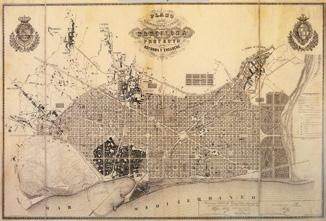
study the past; we inherit it, and inheritance brings with it not only the rights of ownership but the duties of trusteeship."
The discourse surrounding the transformation of urban spaces is both timely and essential, as the delineation between indoor refuge and outdoor time becomes ever more pronounced. As we spend more time indoors, our time outside our homes becomes even more precious. This makes it imperative for our urban environments to provide us with a healthy dose of well-being.
The narrative of urban planning is evolving profoundly, transitioning from designs that prioritise vehicular movement to those that advocate for human scale and environmental sustainability. We can observe this shift as the more enlightened cities drive the gradual reclamation of spaces for pedestrian use, the proliferation of green infrastructure, and

the heightened emphasis on accessible, welcoming public realms. Cities such as Rotterdam and Paris exemplify this shift with their innovative approaches to urban redesign and commitment to enhancing the quality of life for their residents.
Catherine is fully immersed in this sentiment. When speaking about how they regard their role in society, she states, "If you make an area welcoming and functional, it has ripple effects across the whole community. People look after spaces they value, crime decreases, and health indicators improve. We strive to build long-lasting products that benefit the public," she says. "Our decisions are made with a better future in mind."
So, how can cities accelerate this transition? Catherine believes the private sector has an important role to play. "The private sector has a moral imperative to lead this charge," she contends. "Businesses must demonstrate the potential and value of sustainable, human-centric urban design. Every park bench, planter, and element we introduce into the urban fabric should testify to our belief in a more beautiful, connected future." This is the way she leads Furnitubes—to set an example through sustainable practices and innovative design that puts people first.
Peering into the future, Catherine adopts an optimistic stance regarding the trajectory of urban planning. She envisions cities that wholeheartedly embrace human-centric design, fostering
Barcelona's planning by Cerdà was revolutionary; he considered air quality and pedestrian space, laying the foundations for urbanisation focused on human well-being.
livable, enriching, and inclusive environments. This forward-looking perspective champions the idea that well-conceived urban spaces can act as catalysts for community, creativity, and well-being, reflecting a broader commitment to building cities that not only function efficiently but also resonate on a deeper, more personal level: "We have a responsibility to leave a legacy of functional beauty. Beautiful outdoor spaces add value to the lived experience of all who use them. This is what great cities do."
There are bright spots to build on. Innovative urban projects worldwide offer glimpses of what is possible, and a new generation of planners, designers, and citizens demands better. "The time has come for urban spaces that welcome and uplift us all," Catherine concluded. If we keep this vision in mind, the cities we get are the cities we deserve.
MONEY THE DESIGN, ARCHITECTURE & URBAN PLANNING EDITION 59 URBANISM
Cerdà’s modified plan, in 1859
The Strand, 2023
Forms of Beauty
MONEY's pick from the world's best designers.
The BMW Vision Neue Klasse X, set for a 2024 preview, epitomises the evolution of electric mobility with a homage to BMW's heritage through its iconic thin kidney grille design. This futuristic SUV reintroduces a beloved aesthetic from the 1970s and 1980s and promises cuttingedge advancements with a 30% increase in range, faster charging, and enhanced efficiency. With a sleek, modern design and a minimalist interior focused on reducing carbon footprints, the Vision Neue Klasse X is poised to redefine electric luxury
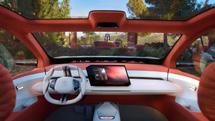


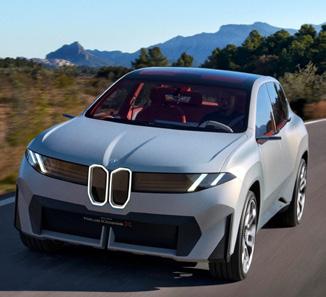
A Japanese artist, Mariko Mori, created the stunning architectural masterpiece Yuputira House. The house is located along the shores of Miyako Island and was built as a private studio for the artist. The coralshaped structure is made of pure white concrete and is a tribute to the oceanic charm of the site and Mori's unique style. The design features sweeping curves, pristine rooms, and ample daylight that create a sense of endlessness and a space of contemplation. The construction of this labour of love was a joint effort between local practice Ring Architects and Japanese artisans.
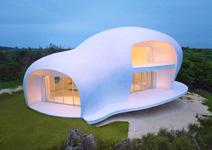
ISSUE 80 MONEY 60
DESIGN
French designer and craftsman Paul de Livron has recently revealed the Apollo Wooden Wheelchairs, a unique and eco-conscious approach to mobility aids that combines aesthetic and high-performance appeal. These wheelchairs are the world's first and only ones crafted entirely from wood. The first beneficiary of this design was Pope Francis, the most famous person on earth. The papal model of the wheelchairs is ambitiously designed to include two pieces of wholly charred 12th-century oak beams from the Notre Dame Cathedral as armrests.



Louis Vuitton has introduced a new high-watch-making timepiece designed by Frank Gehry. The watch features a translucent sapphire crystal highlighting the rose gold- and rhodium-plated gears, plate, and flying tourbillon. The Poinçon de Genève, an independent organisation that ensures the quality of all watchmaking components, has certified this watch as part of the Louis Vuitton High Watchmaking Series. Previously, Frank Gehry collaborated with Louis Vuitton on a handbag collection during Art Basel Miami in 2023. →
Bolon is a Swedish family-owned company innovating premium flooring and rugs for 75 years. The company is firmly committed to sustainability, which began in 1949 when it started creating rag rugs from discarded materials. Since then, Bolon has continued to redefine the design industry by pushing the boundaries of creativity and environmental consciousness. Today, Bolon weaves waste into stylish and environmentally friendly solutions, making it a pioneer.

MONEY THE DESIGN, ARCHITECTURE & URBAN PLANNING EDITION 61
DESIGN
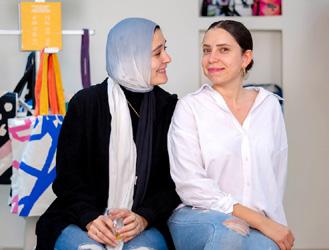
Semblance, an industrial design studio, has debuted with the Breeze Block stereo. The project combines audio with the visual and tactile appeal of decorative masonry units of the same name. Jacob Boyd and Benno Schmidt, two industrial design students, are responsible for the project. The pattern for the project was found on the streets of Montreal, Canada. It features four-way symmetry, simple geometric shapes, and pointed corners, which are quintessential of mid-century modern breeze blocks.
Up-Fuse is a brand that aims to positively impact the environment by redefining slow fashion. It offers high-quality and competitively priced sustainable fashion items. Up-Fuse is based in Cairo, where sustainability is still a new concept. It repurposes plastic waste and tyres to create products such as laptop sleeves, wallets, clothing, and shoes. Since its inception in 2013, Up-Fuse has successfully repurposed over 2 million plastic bags, 800,000 plastic bottles, and 800 car tyres into sustainable apparel and accessories.



The Disassembly Lab footwear design speaks for itself and doesn't require much explanation. Its aesthetic appearance alone is enough to win your heart, even before you try it on. This is a hallmark of excellent design! The clever construction of the footwear allows for easy disassembly, making it simple to repair and recycle. The shoe is split into two halves—the upper body and the outsole—that can be held together using rivets and plugs, where you can loop a rubber band. The rubber band holds the halves together and adds flexibility to the shoe during movement. This unique design is visually distinct, with the rubber band becoming an iconic element that symbolises sustainability.
ISSUE 80 MONEY 62 DESIGN
Did you know that people consume around 2.25 billion cups of coffee daily? However, many of these cups are made using machines, resulting in many coffee pods that end up in the garbage after use.
To address this problem, Keurig has introduced the K-Round, a compostable and plastic-free alternative to the traditional coffee pod.
The K-Round is a compressed disc or puck of coffee grounds bound together with plant-based materials like cellulose. The K-Rounds are compatible with Keurig's new machine, the Alta, which can process and extract coffee from them without leaving behind a plastic and metal coffee pod.


Firefly, a bike manufacturer, produces custom-made bikes, including its latest titanium mini Velo travel bike. This particular bike is tailored to the needs of Ming Thein, the founder of Ming Watches, and comes with a detachable design that allows it to fit inside your luggage. The bike's frame and fork are made of titanium, and the frame features 'Z couplers,' which will enable the bike to be broken down into two pieces. Taking the bike apart is quick and straightforward, starting with unfastening the rear part from the front.

MONEY THE DESIGN, ARCHITECTURE & URBAN PLANNING EDITION 63 DESIGN
BEAUTY AND THE BEST
Express undying love with MONEY's selection of fashion pieces.
[All items available from mrporter.com, unless otherwise specified]

LORO PIANA
Linen t-shirt

KAPITAL
Distressed Intarsia cotton-blend sweater

JIL SANDER
Belted tapered pleated cottoncanvas trousers

FRESCOBOL CARIOCA
Sergio straight-leg linen-blend drawstring shorts
NIKE
Cortez leather and mesh sneakers

ISSUE 80 MONEY 64 FASHION
€470
€555
€110
€1,250
€185

CHRISTIAN LOUBOUTIN
Logo-embellished leather loafers

KARTIK RESEARCH
MONCLER
Clai logo-detailed webbing-trimmed quilted shell hooded down gilet


Multicoloured printed silk shirt


SACAI
+Carhartt WIP straight-leg belted woven trousers
AMIRI
Camp-collar printed silk-twill shirt
TUDOR
Titanium bezel black carbon insert, 43mm black carbon composite case with a matte finish
/ elcol.com

MONEY THE DESIGN, ARCHITECTURE & URBAN PLANNING EDITION 65 FASHION
€920
€715
€870
€995
€5,320
€370
RUNE BO JAKOBSEN
A Visionary Artist Transforming Malta into a Green Haven
Renowned Danish artist, sculptor, and architect Rune Bo Jakobsen, who has called Malta home for the past two decades, is on a mission to infuse the Maltese landscape with a breath of green life.
Jakobsen is an established artist who has held numerous solo exhibitions. In his recent series 'Green City', he continues to celebrate the beauty of the Maltese islands while drawing attention to the pressing need for environmental conservation. The paintings, characterised by bold brushstrokes and vibrant hues, capture the essence of Malta's unique charm, emphasising the importance of preserving its remaining green spaces.
Jakobsen's vision extends beyond the canvas into his public artworks, including the travelling 'Popcorn', 'Olive Twist' in Żejtun, and his ongoing sculptural project, the 'Embryonic Horse', scheduled for inauguration in spring 2024. Jakobsen's studio in Birkirkara serves as the creative hub where his paintings and sculptures come to life. Embracing a broad palette and drawing inspiration from the everchanging Mediterranean skies, his artwork showcases a deep connection to the Maltese landscape.
In the realm of architecture, Jakobsen's enduring commitment to integrating green spaces has been his hallmark, including his design contributions to the Valletta Waterfront, the Cottonera Regeneration



Project, and the Quad, where green spaces are seamlessly woven into the fabric of the developments. These projects embody his vision for a sustainable and harmonious urban landscape, promoting the use of bicycles and maximising the pedestrian areas and central piazzas for community engagement, a typology that could evolve. Born in Denmark, Jakobsen brings a unique perspective rooted in a culture that prioritises cycling and pedestrian infrastructure. Drawing parallels between his hometown, Aarhus, and Malta, which are approximately the same size, he envisions the entire island as one interconnected town, advocating for a network of walkways for pedestrians and cyclists.


"It would boost our health, help reduce the number of vehicles, and improve the quality of the air around us."
In Rune Bo Jakobsen's artistic and architectural endeavours, the heartbeat of Malta's green potential resonates. As he continues to create, inspire, and advocate for positive change, Jakobsen invites us all to join in the collective effort to make Malta not only a visually stunning destination but also a thriving haven of sustainability for generations to come.
www.runejako.com
ISSUE 80 MONEY 66 ART
Lija (2023)
Fort St Angelo (2022)
Valletta in Green (2023)
Old Theatre Street, Valletta (2022)
fmlifestyle.com
2024
Malta's fashion magazine since 1979

There is a NEW Cookie in Town. Indulge with taste. scan for more






































 Nagoya Zokei University
Nagoya Zokei University

























































